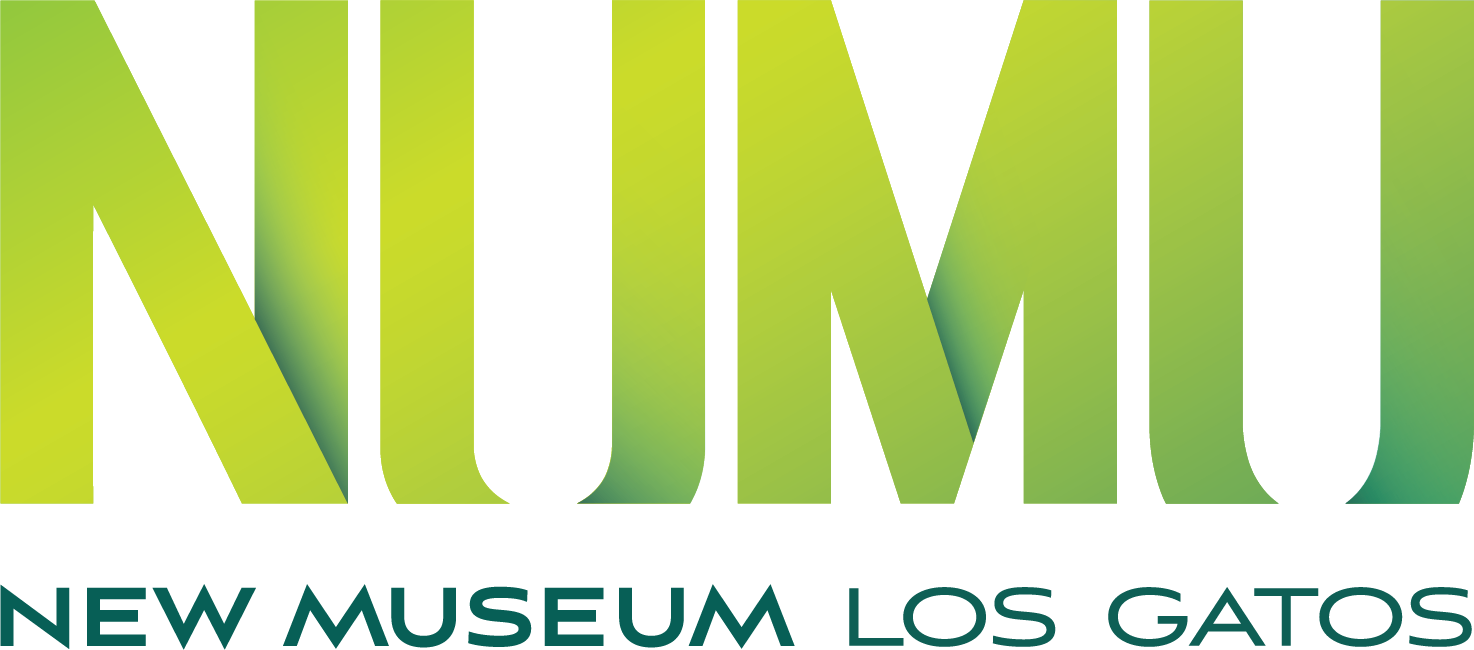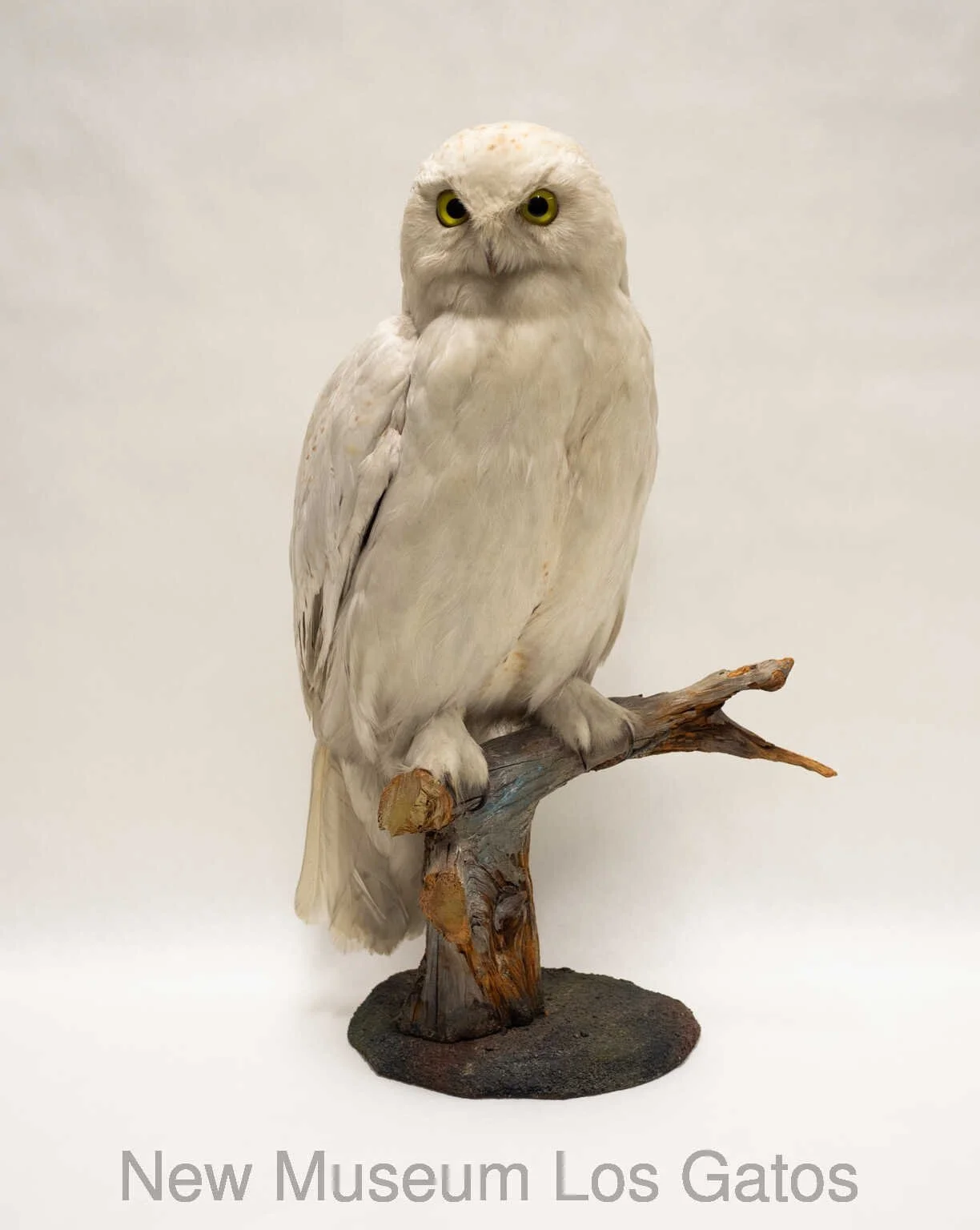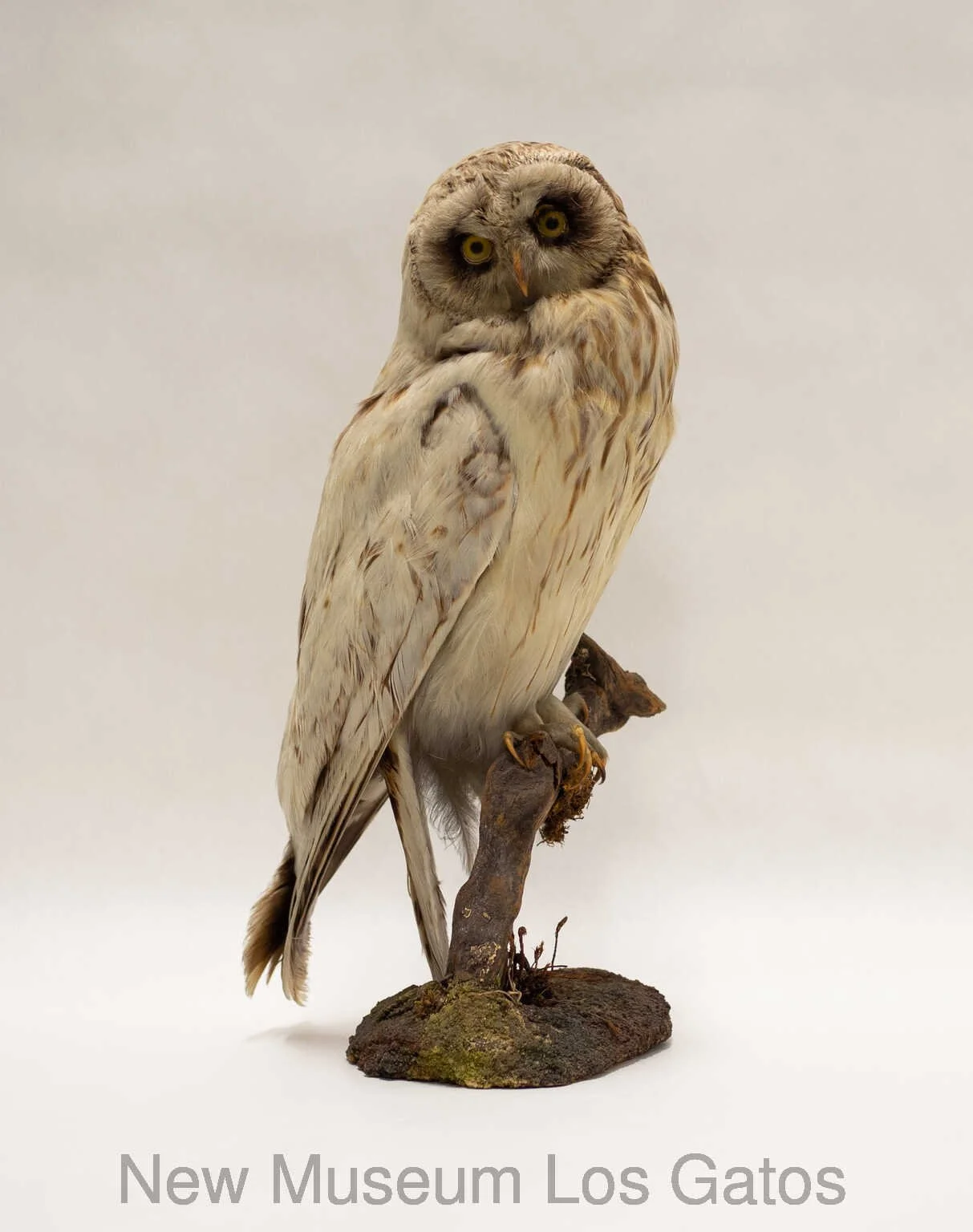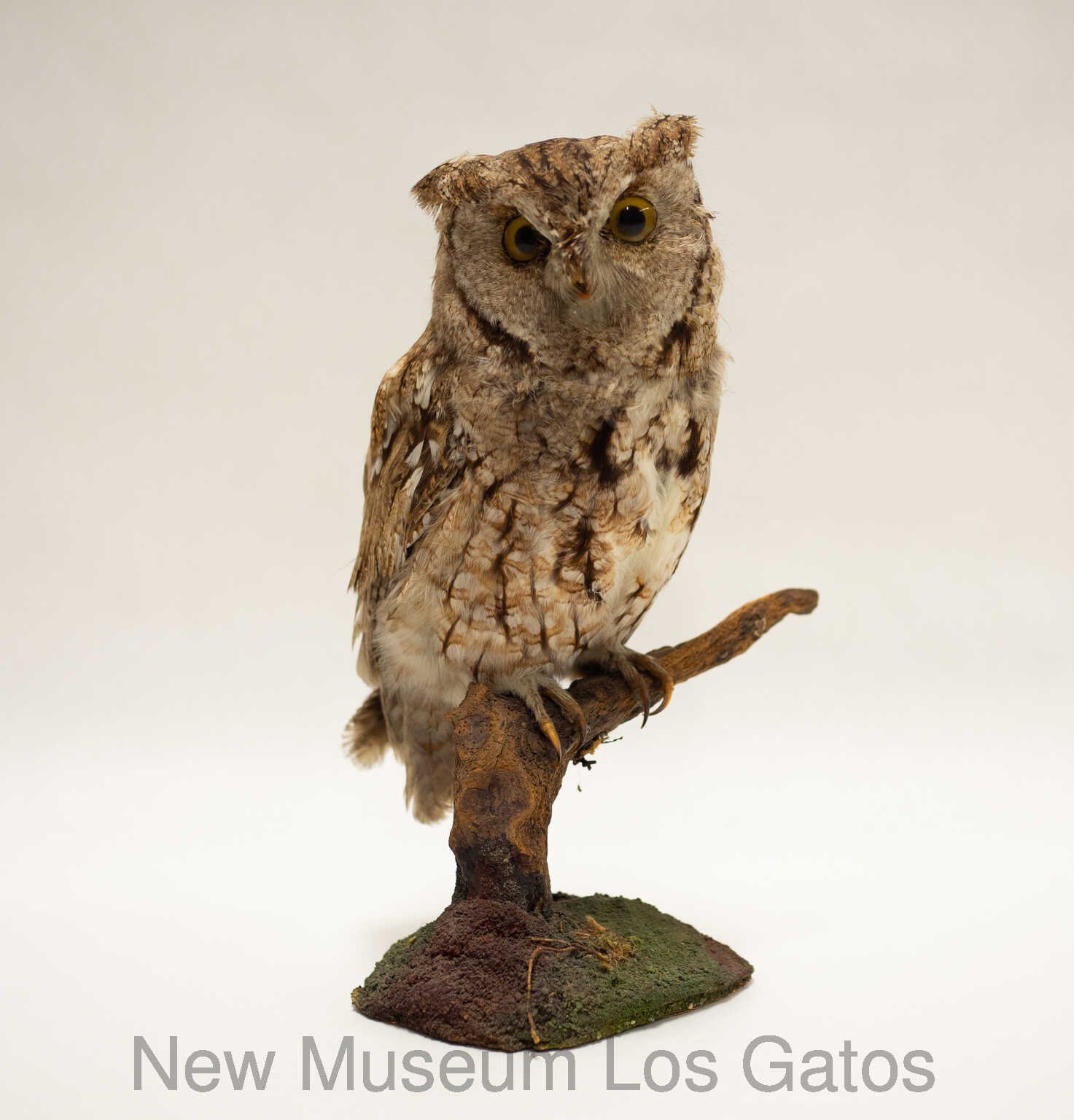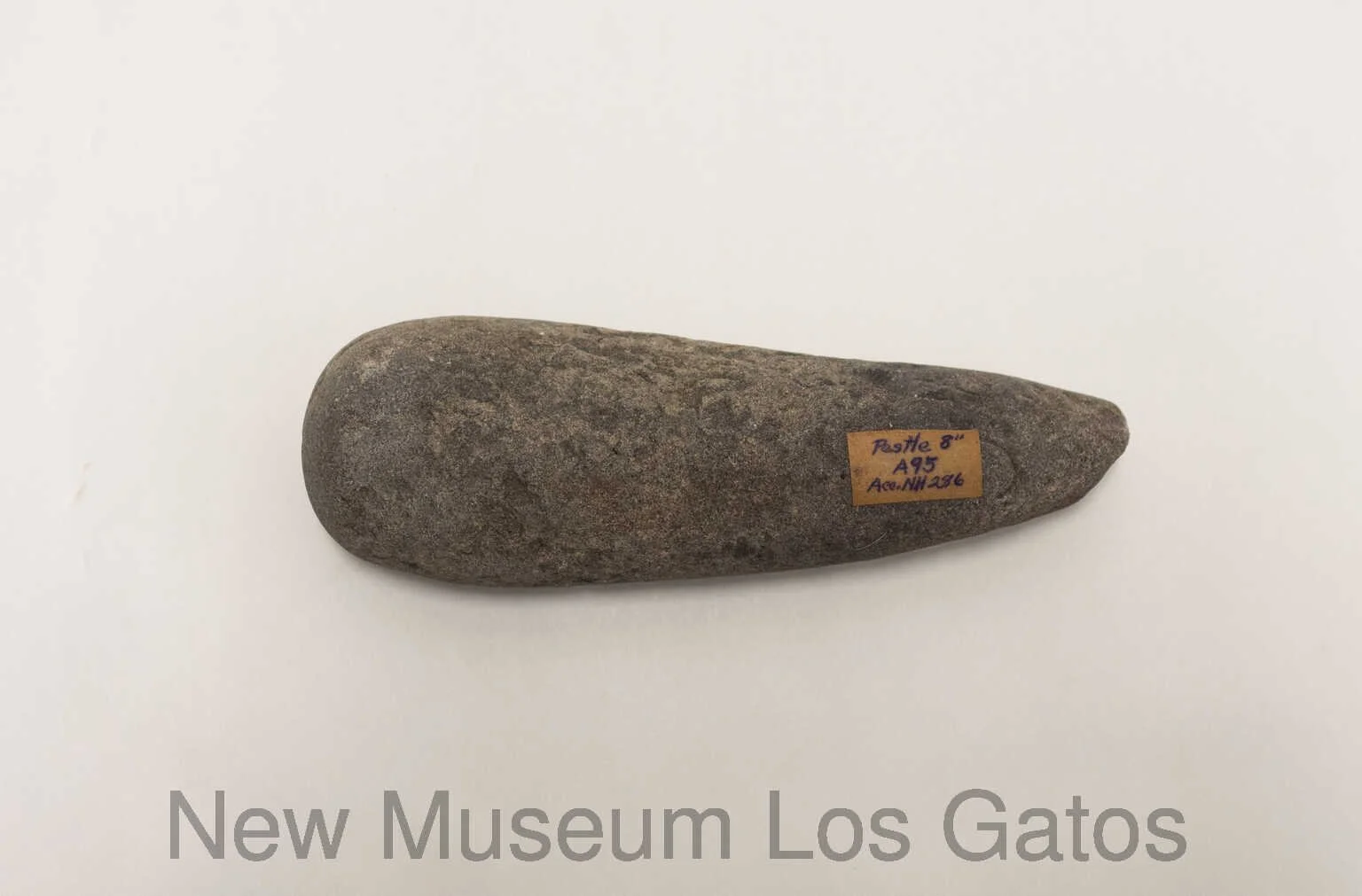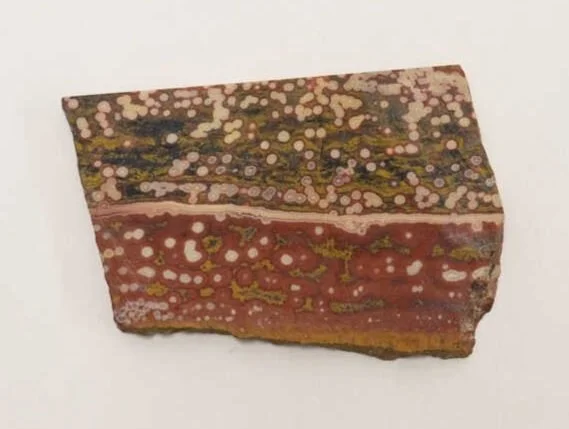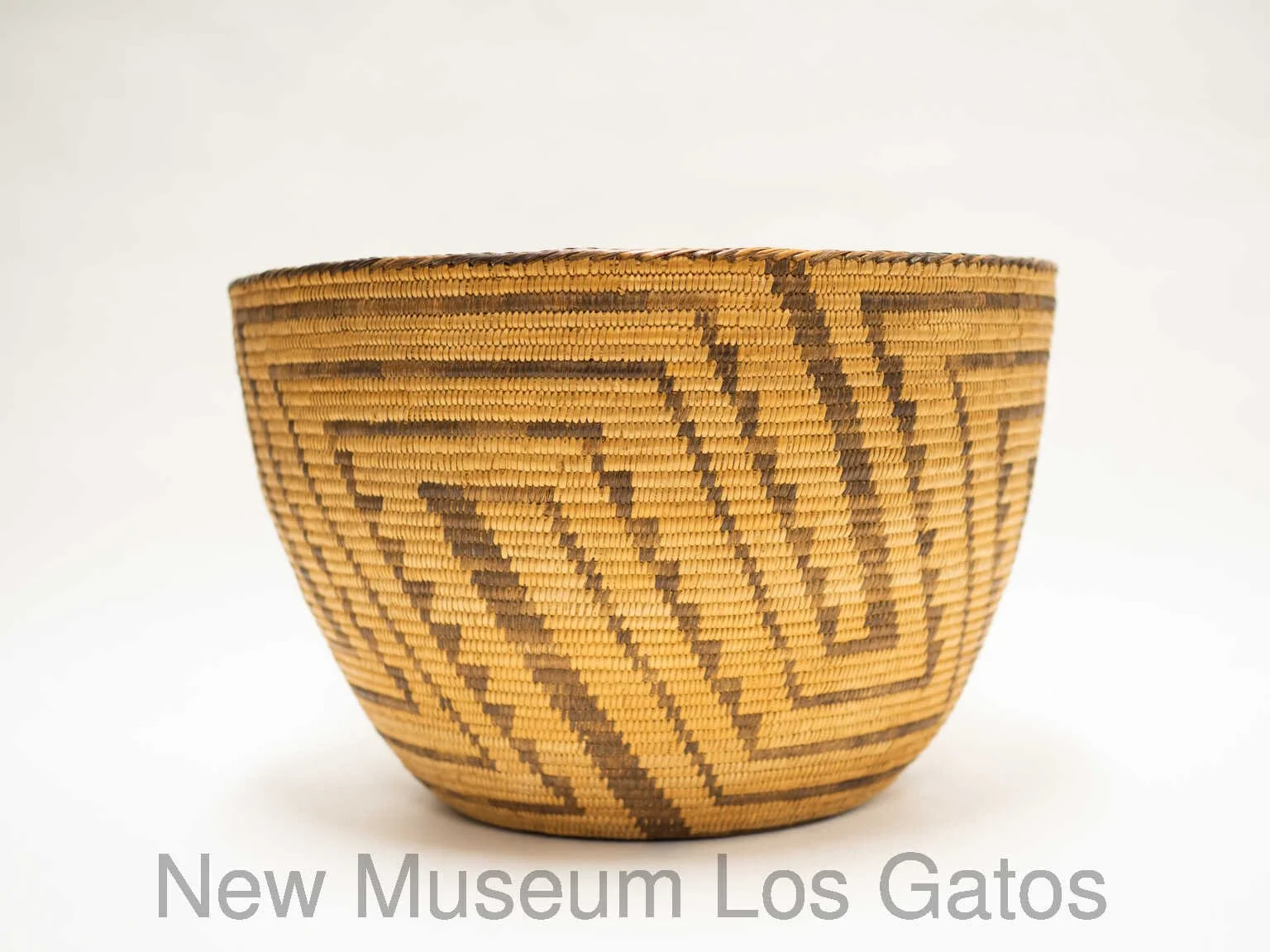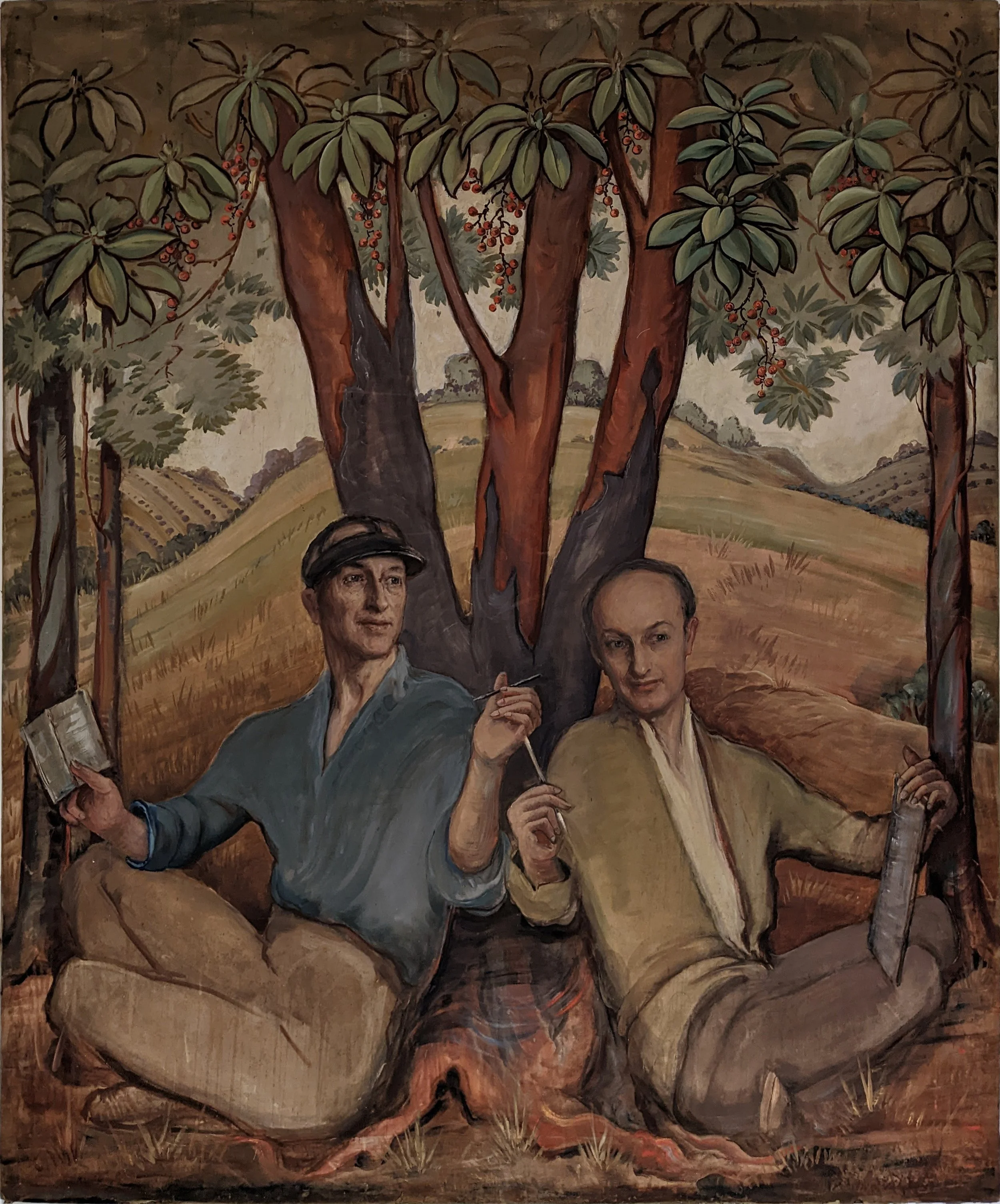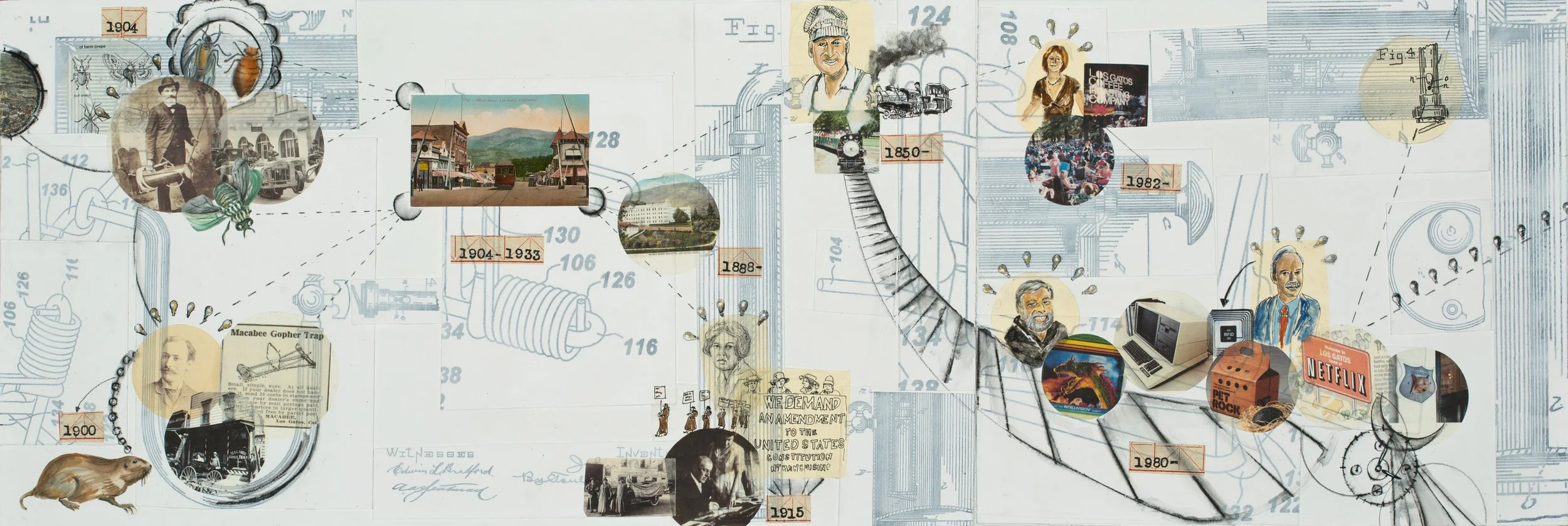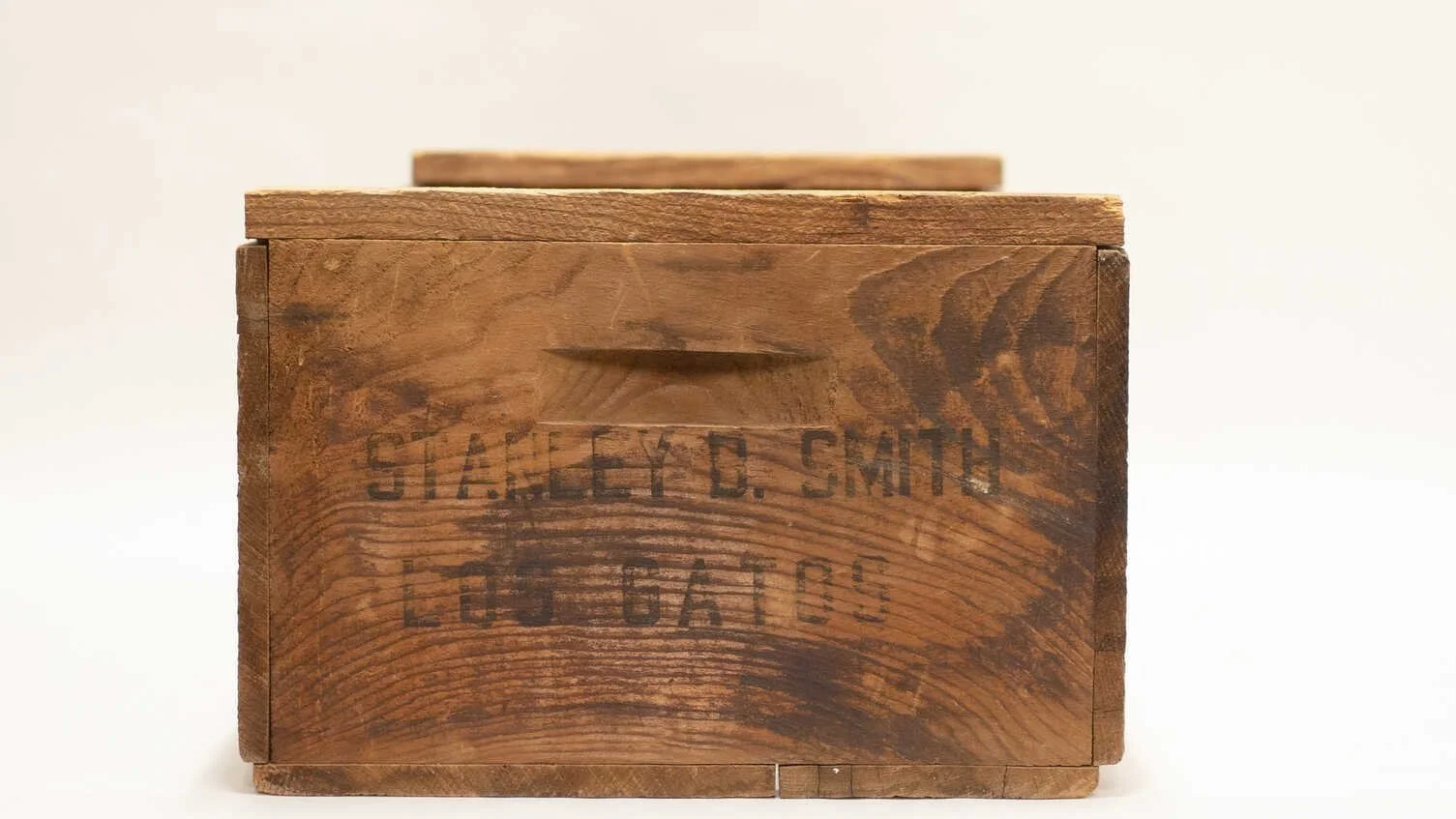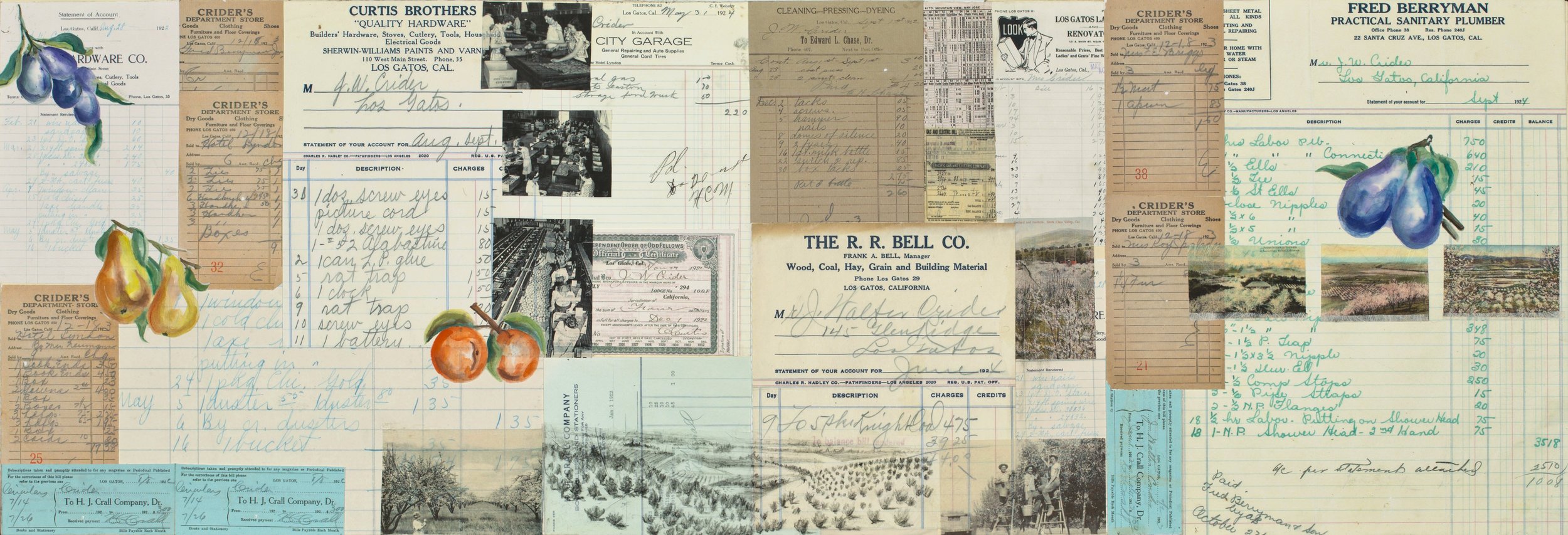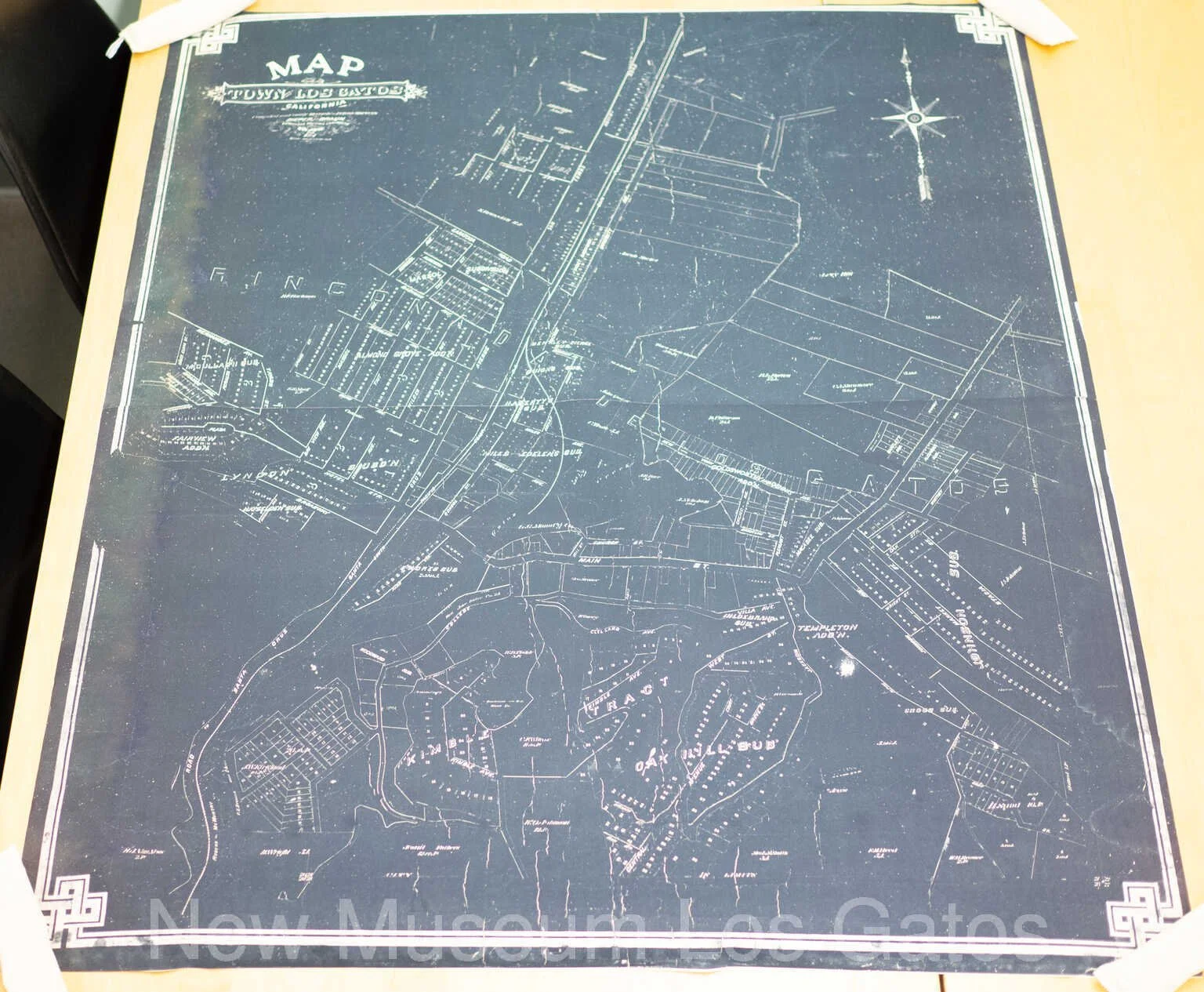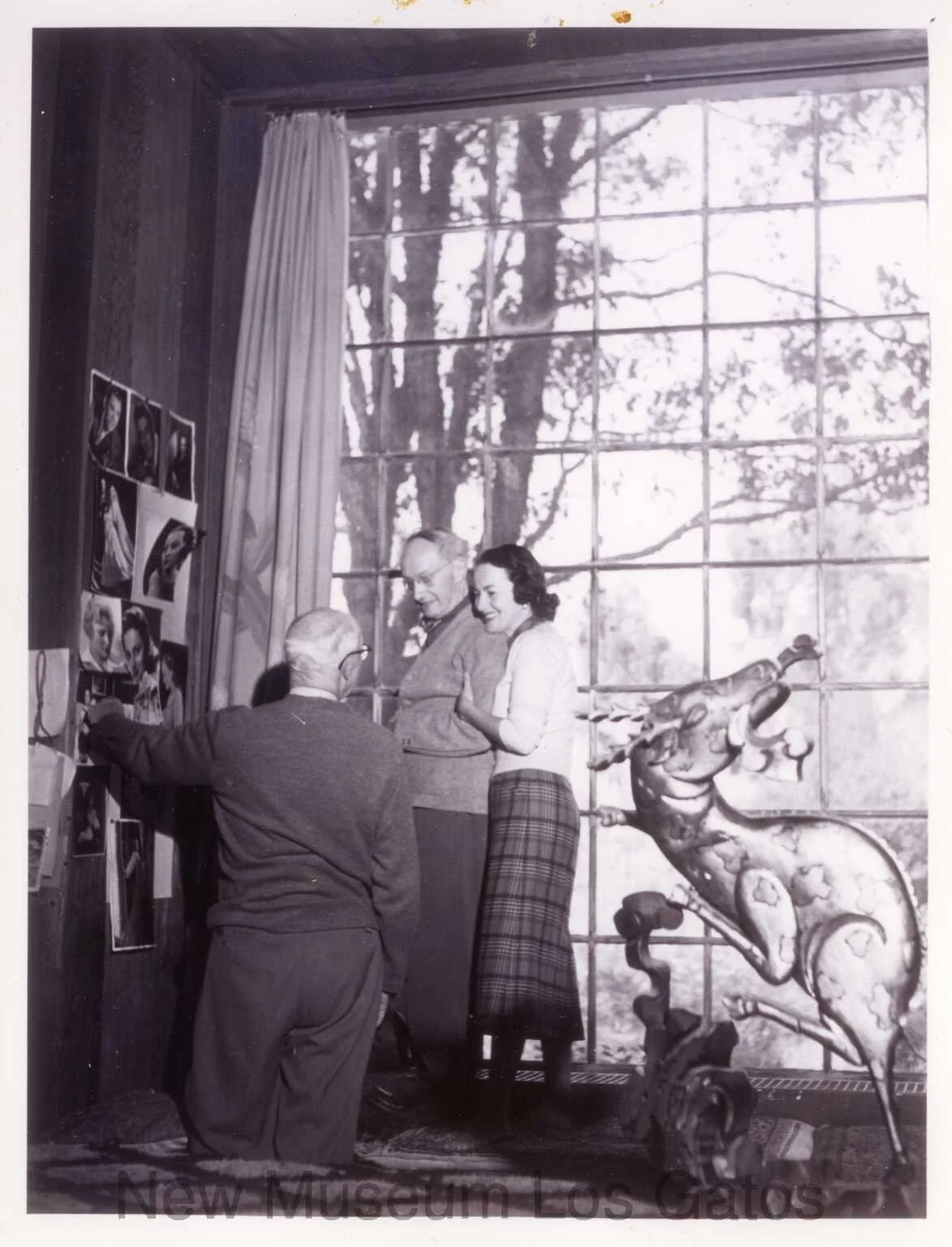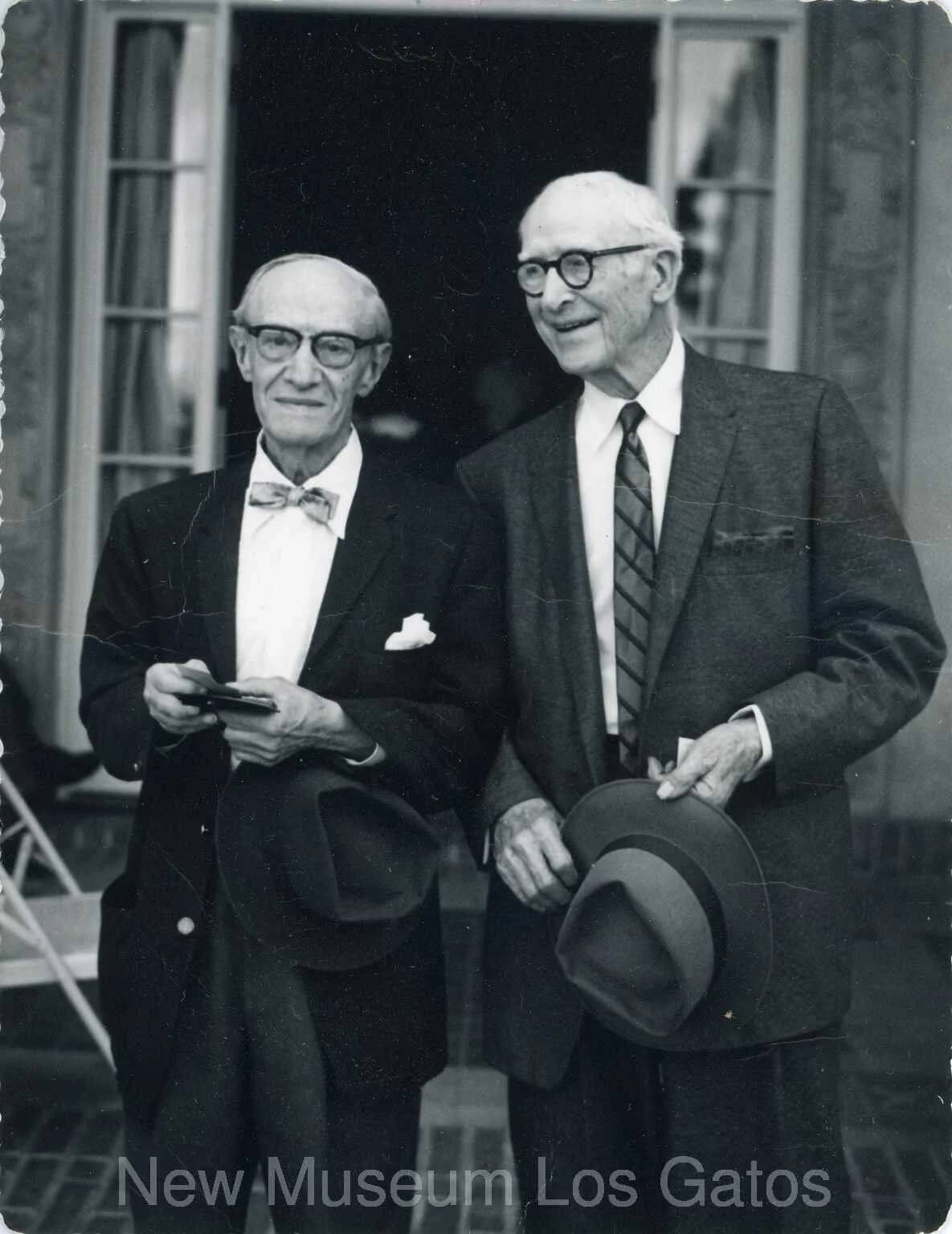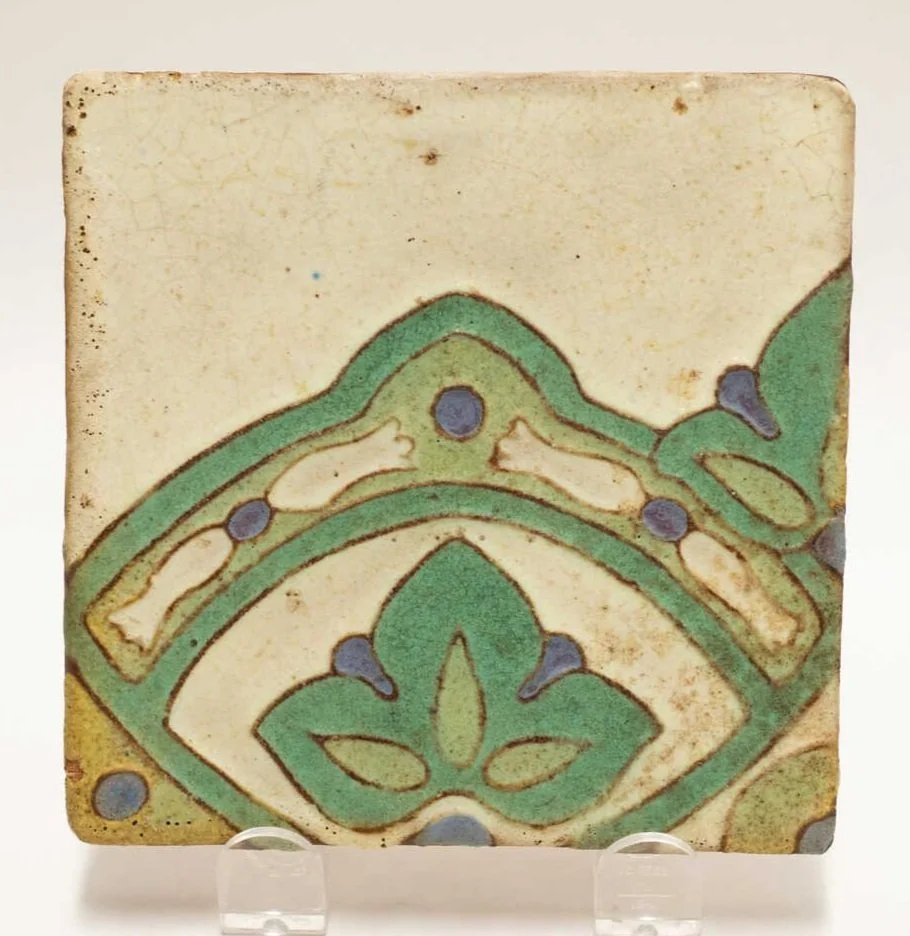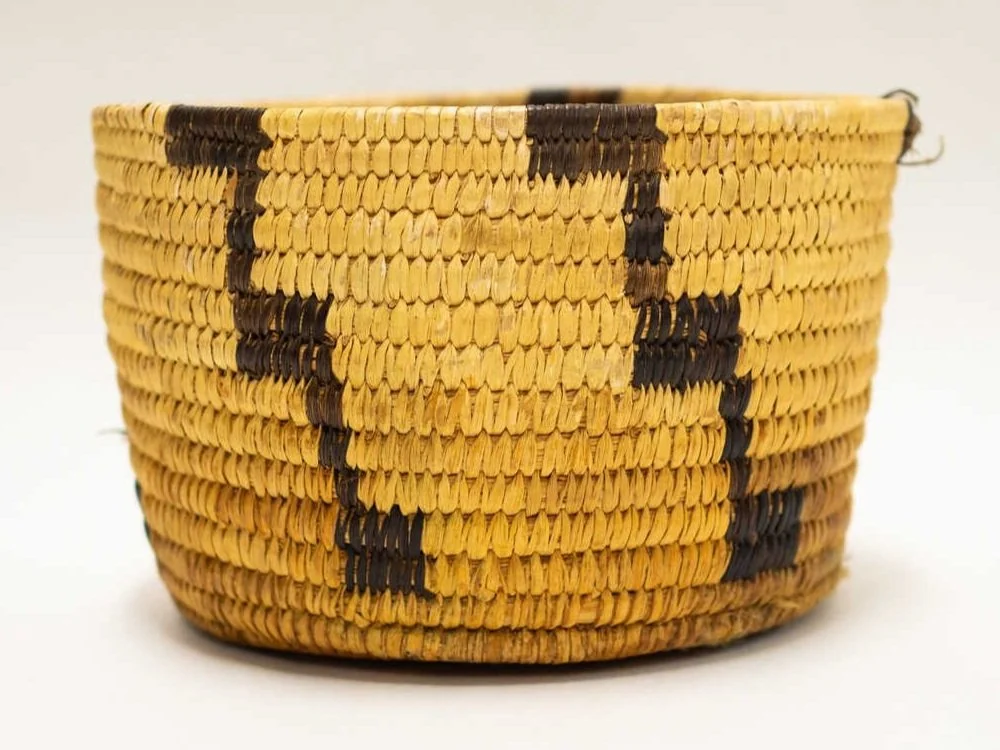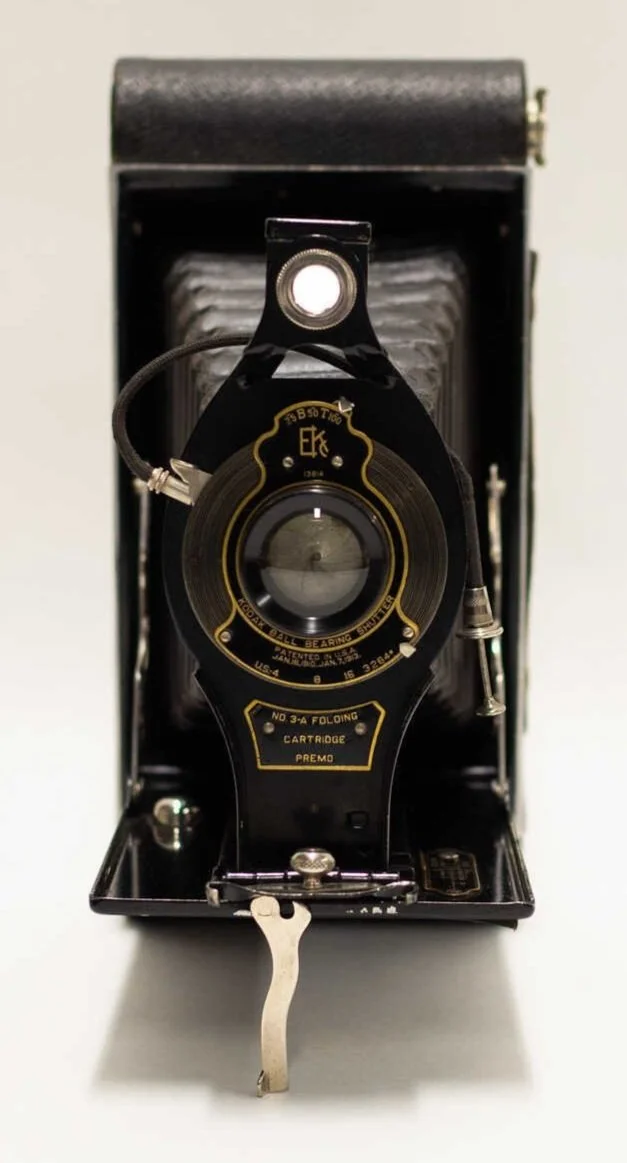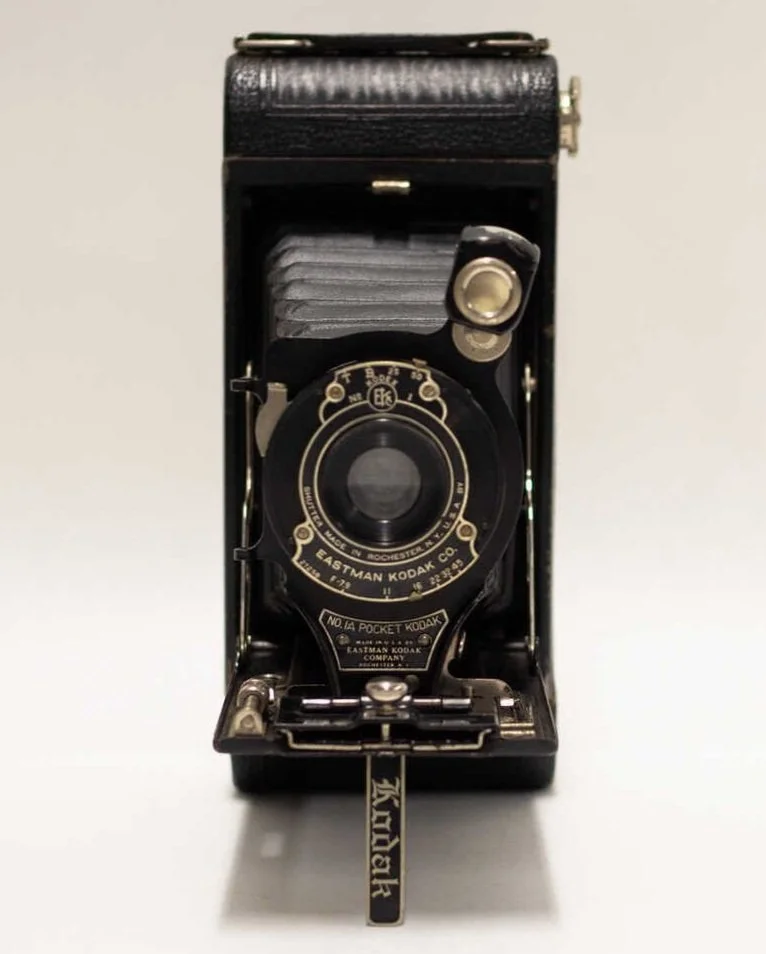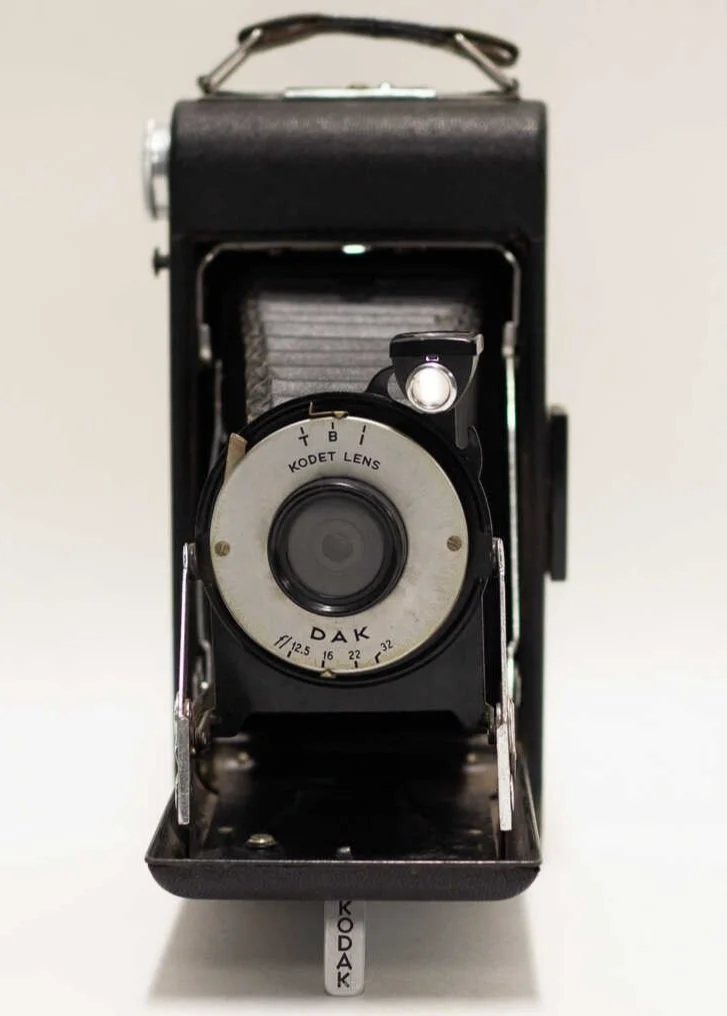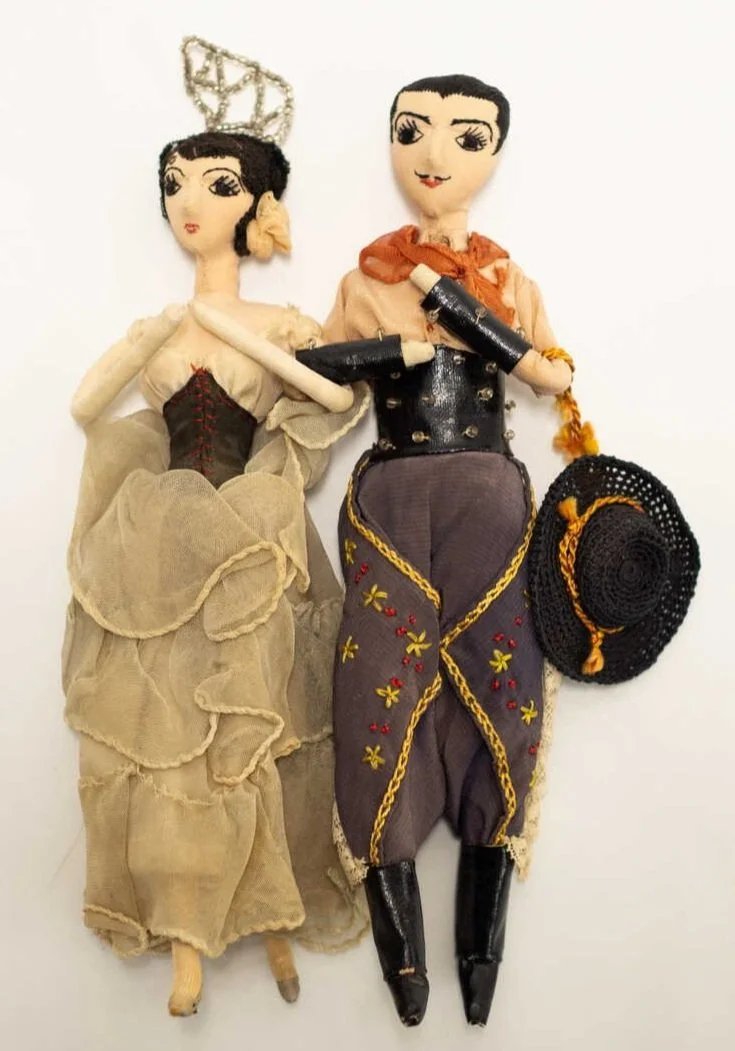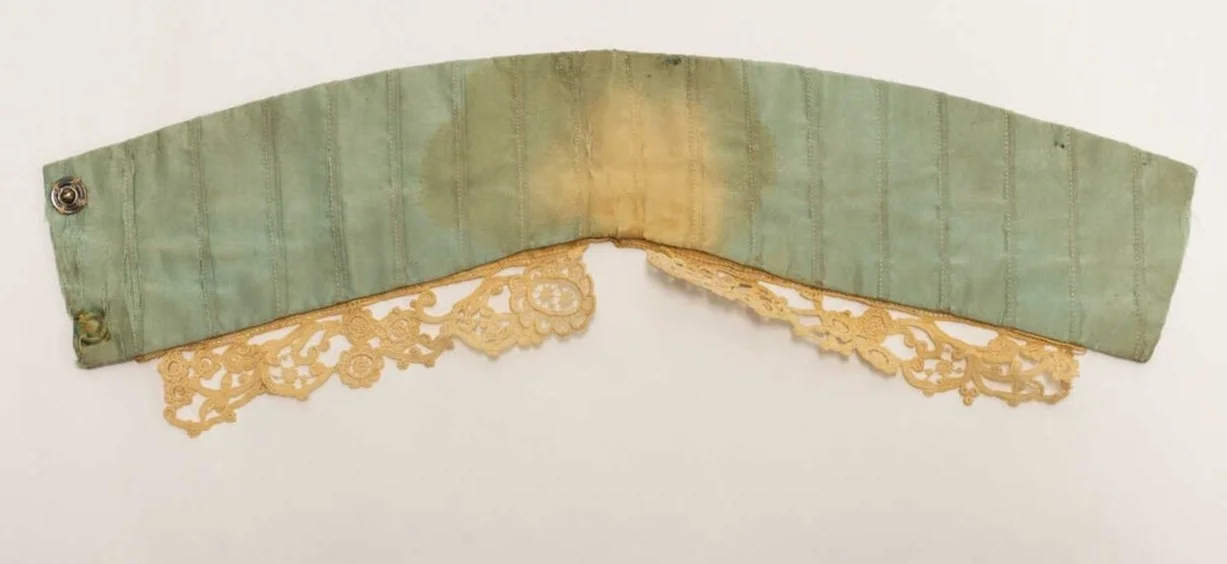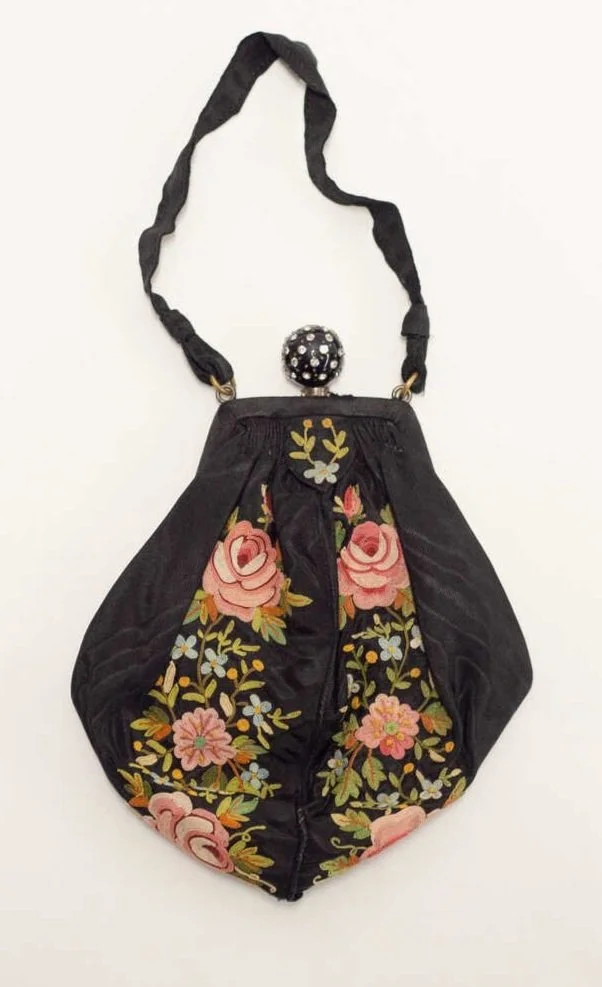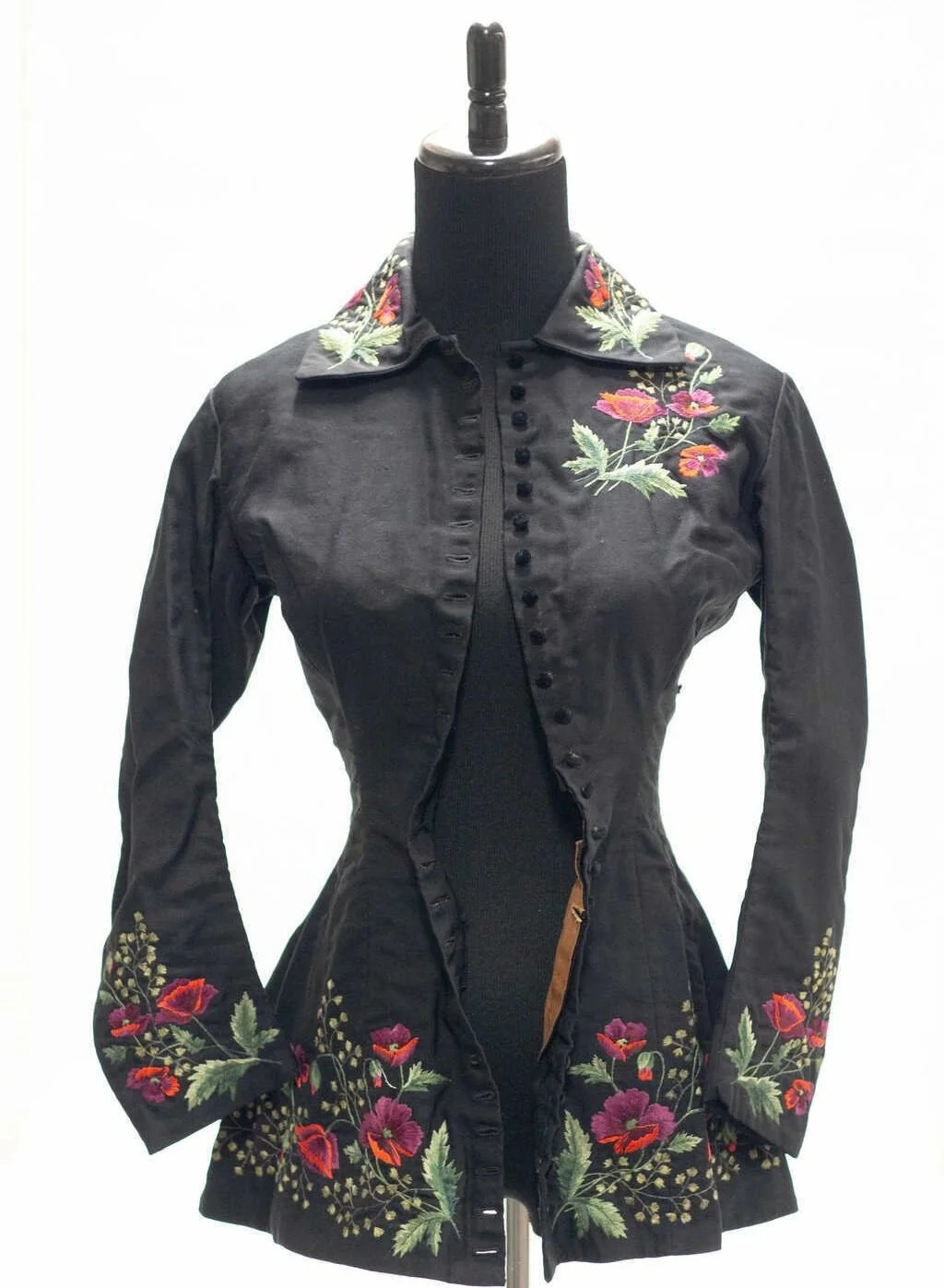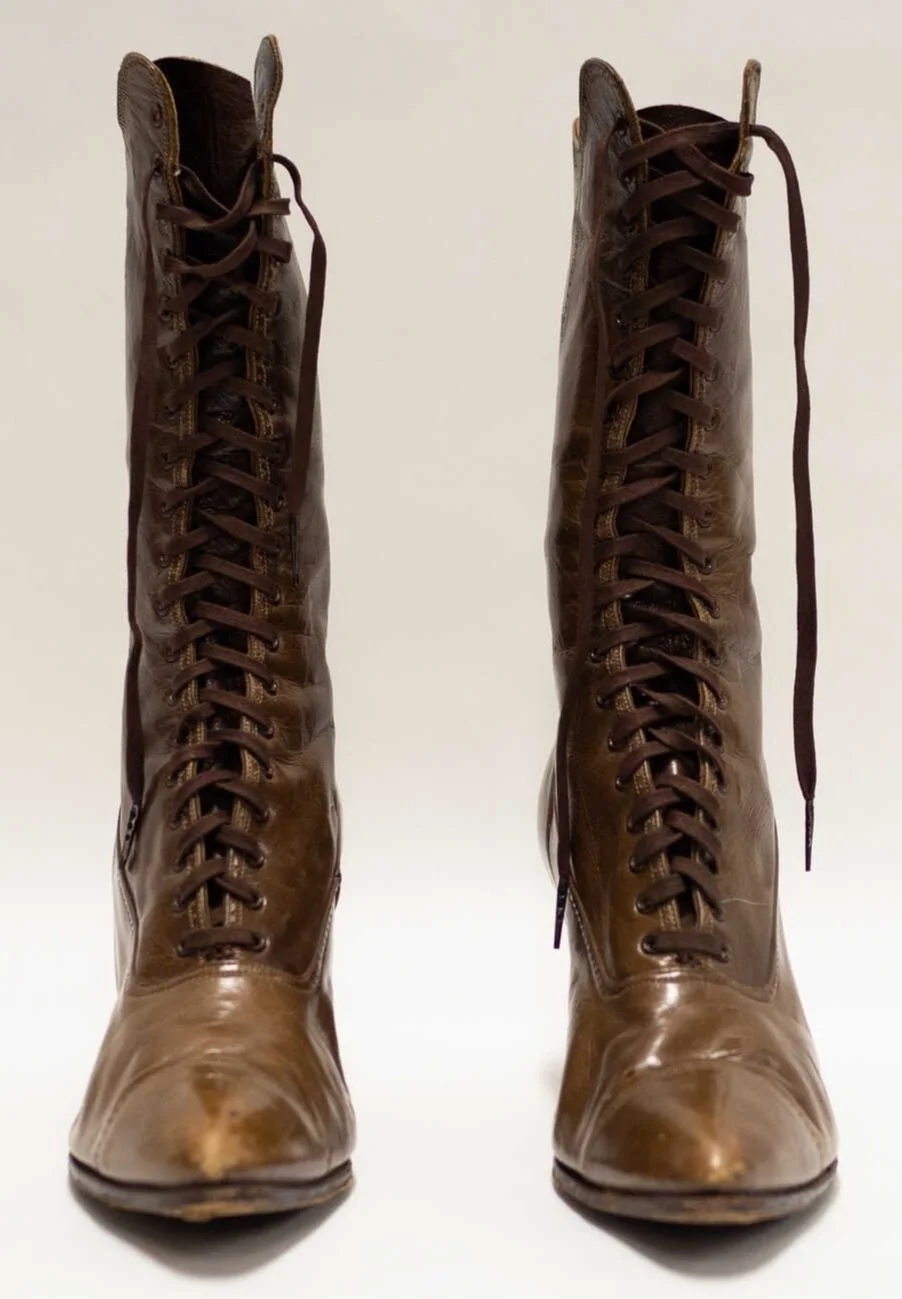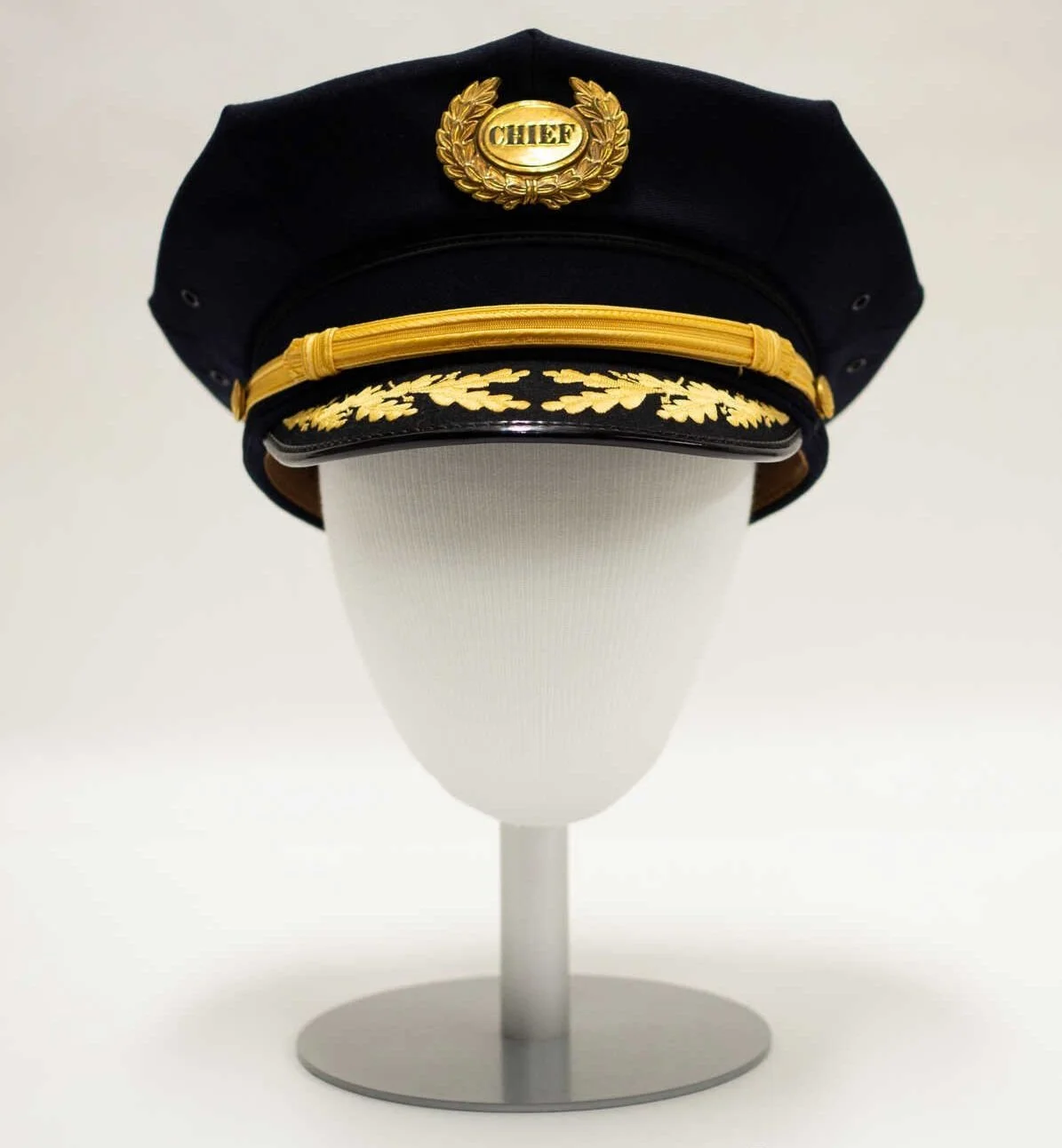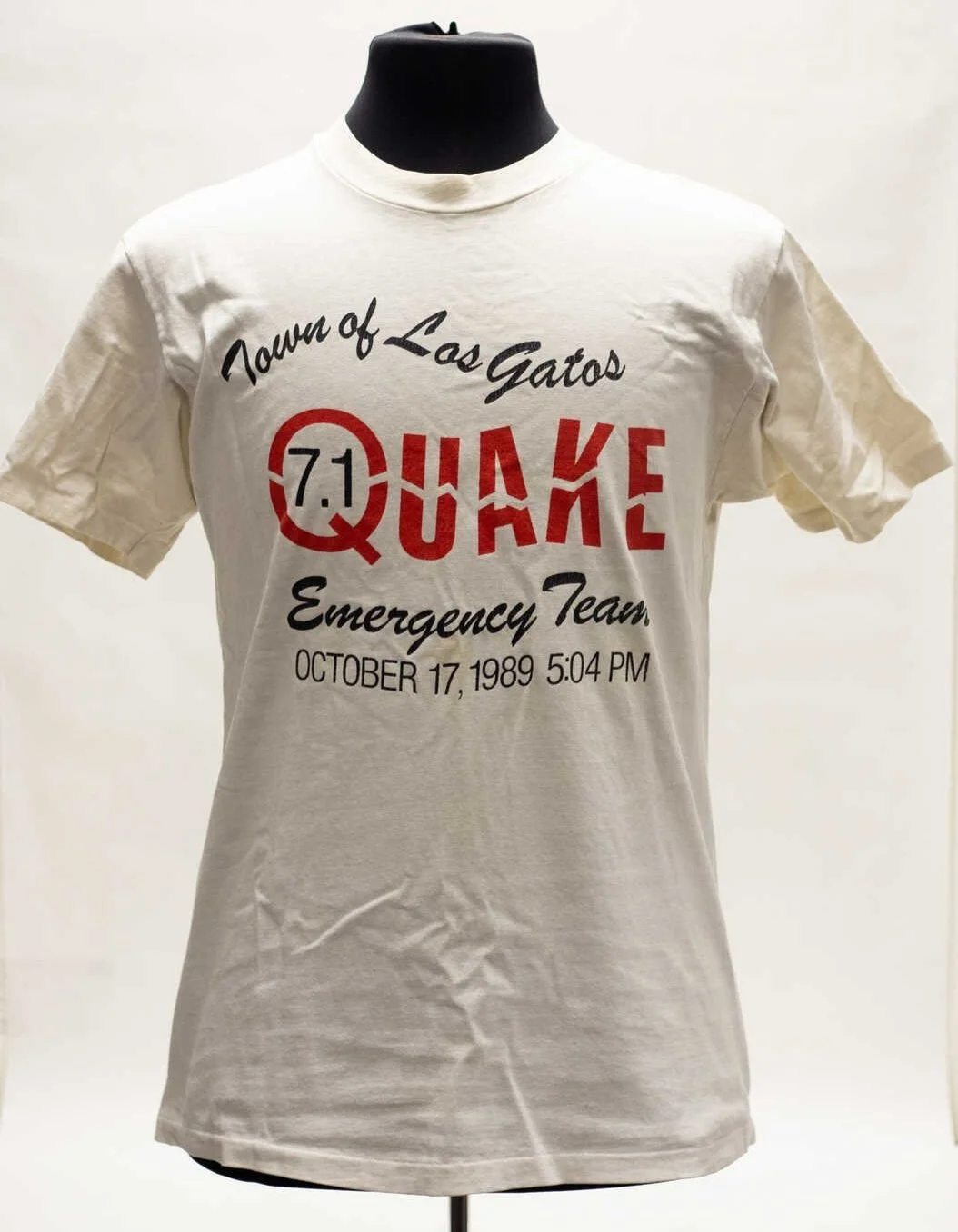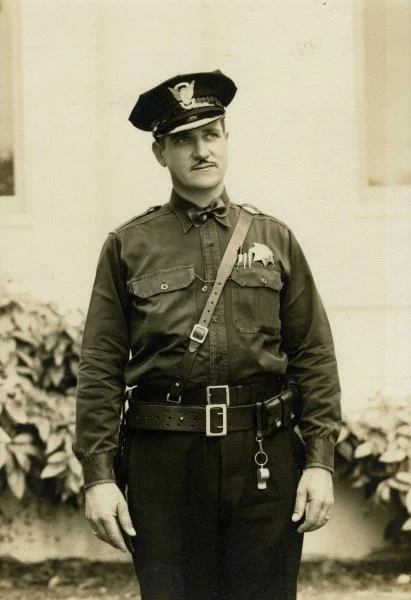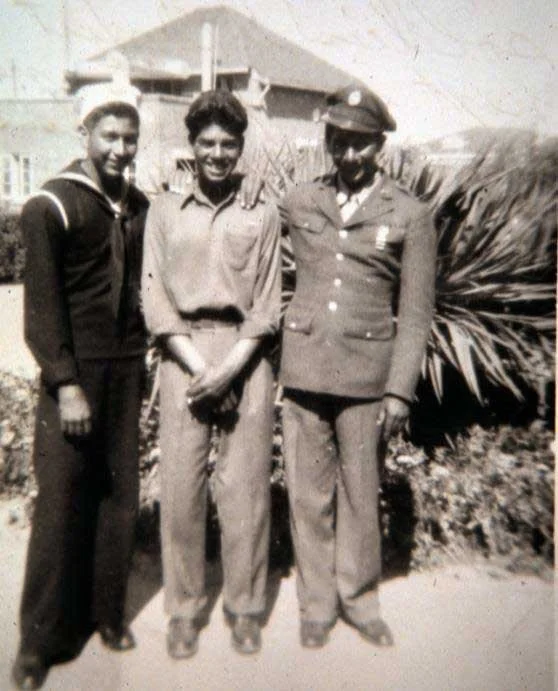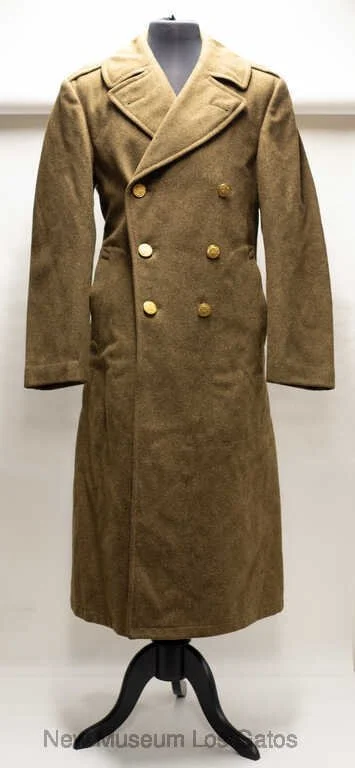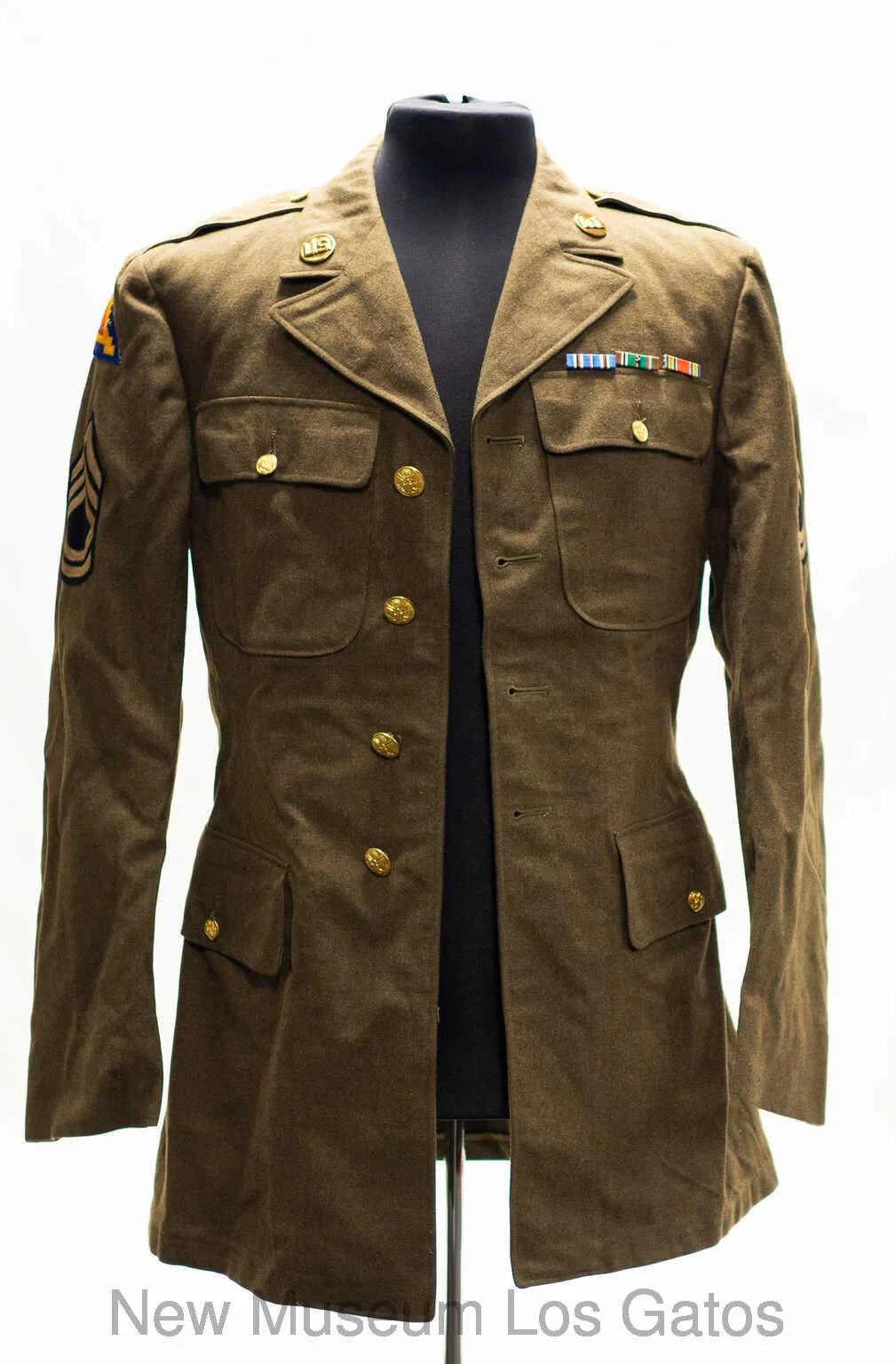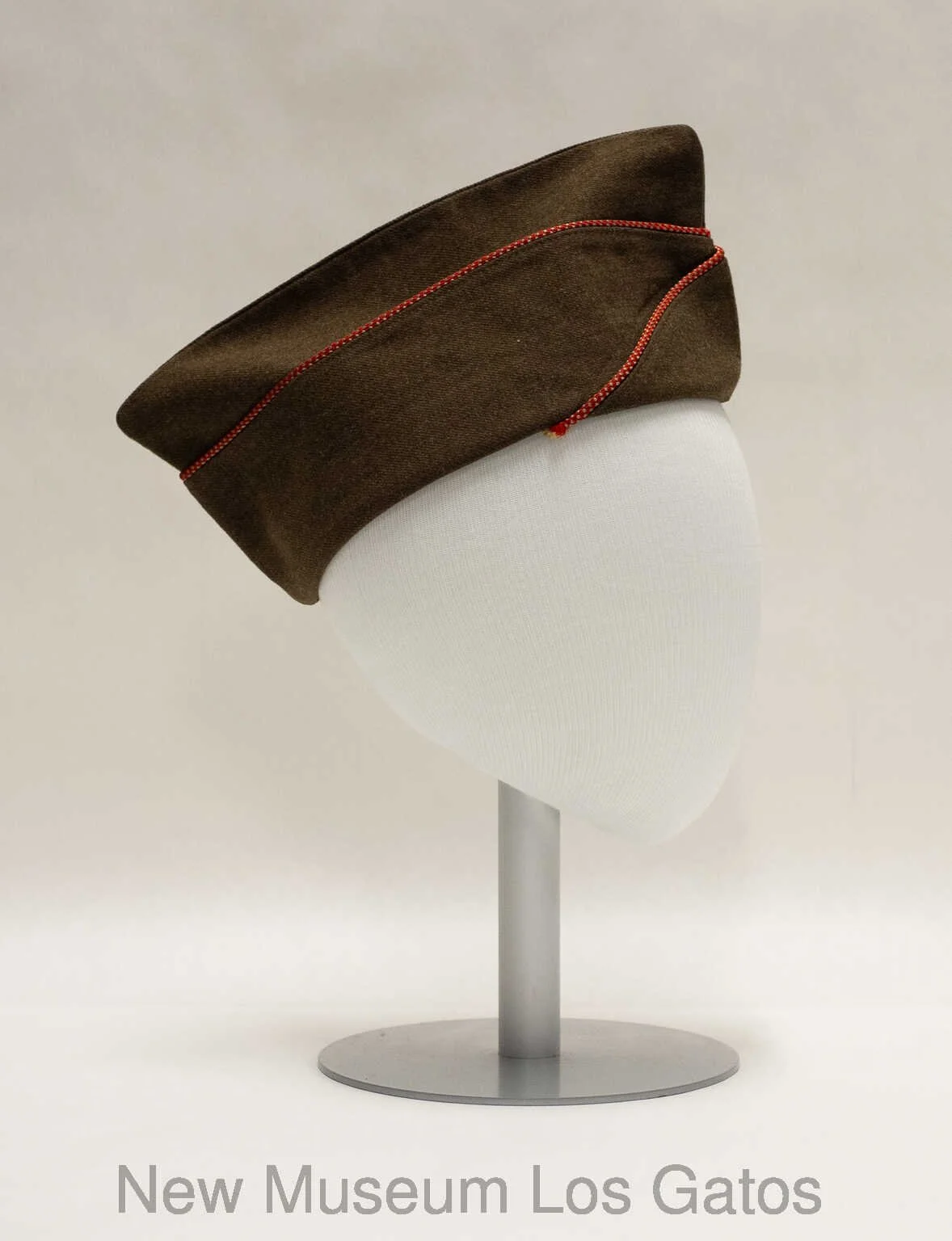Thanks for visiting New Museum Los Gatos (NUMU)! Below you will find images of the different objects displayed in the exhibition and related text for easier accessibility. Some of the objects can also be found on our Catalog-It, a digital catalog of our permanent collection, and their names will link to their page where you can find more information.
If you have any questions, don’t hesitate to ask anyone from the NUMU staff.
Jump to: owls, money vest, painting of the boys, tracks and ties, Hotel Lyndon, agriculture and innovators, growth of the town, the boys, Charley(s), origins, photography, dolls, lacework, clothes, uniforms
Los Gatos History Project: Uncovering Untold Stories
History is a dynamic and ongoing conversation between the past and the present. The Los Gatos History Project adds to this conversation as we delve into our collection to find untold stories of the people and places that make up our town. While we continue to appreciate the well-known and influential contributors, we also wish to uncover the stories of those who contributed in quieter ways. In partnership with our community, we will add to our knowledge of this "gem of the foothills."
The NUMU history collection can teach us about people and their interactions with the world around them. Our varied assortment of artifacts and belongings includes the commonplace and the extraordinary. Each piece tells a story of the conditions, obstacles, and opportunities faced by a diverse array of people who contributed to our town. These are products from an earlier time and technology, reflecting values or customs that may be different from what we recognize today.
At first glance an object might make us think about the person to whom it belonged. If we look more closely, we can begin to ask questions: Who made the item? Who used it? What was its purpose? There is always more to learn. In service to our greater community we ask such questions to bring out the stories of the before, the between, and the beyond of this place.
Taxidermy Owls
Circa 1920s
Gift of Dr. Ethel Dana Atkinson
NU 2021.169-171
Pestle
Date unknown
Gift of Laura Kroninger
NU 2021.168
Manganese Rocks
Date unknown
Donor unknown
NU 2021.173.1-2
Igneous Rock Fragment
Date unknown
Donor unknown
NU 2021.172.1
Nodule (geology)
Date unknown
Donor unknown
NU 2021.174
Hupa Cooking Basket
Circa 1900
Gift of Nino Family or Laura Kroninger
NU 2021.73
Money Vest
Circa 1850s
Gift of George Lagomarsino
NU 2021.129
This money vest, also known as a gold porter, was used to hide and secure gold to a miner's body. Gold porters, which also included money belts, were popular accessories during the California Gold Rush. The small pockets in the vest were most often used to carry gold nuggets and bank notes. Money belts, which were commonly worn with money vests, stored tied leather bags of raw gold dust called pokes.
This vest was the first object donation to the Museum of Los Gatos in 1965. The donor, George Lagomarsino, received this money vest in lieu of rent on one of his rental houses on Park Avenue.
Frank Ingerson and George Dennison
c. 1935
Oil on canvas
This collaborative self-portrait demonstrates how Frank and George were partners in art, love and life. "The boys," as their friends called them, moved to the Los Gatos Mountains in 1911 and called their home, "Cathedral Oaks. The estate became a magnet for like-minded artists and creative types who lived nearby or came from out of town to escape their public lives.
Neighbors and dear friends included controversial writer, C.E.S. Wood and his activist wife, Sara Bard Field who built their own artist retreat at the Cats Estate nearby.
1915, George was appointed chief of the Department of Horticulture for the Panama Pacific International Exposition in San Francisco. Together, they worked on paintings, sculptures, tiles and any other art or craft that sparked their curiosity, often signing both names to a painting.
"The boys" designed several Hollywood homes for movie producers and directors. In the early 1930s they were asked by their friend, Lilian Fontaine to design costumes for a play she was directing in Los Gatos starring her two teenage daughters, Olivia and Joan. This meeting fostered a lifelong friendship with the family. The pair helped launch Olivia d'Haviland's career when they took her as a teen to Hollywood for her first screen test.
World famous violinist, Yehudi Menuhin also sought refuge and peace from his extensive travel schedule as a musician at Cathedral Oaks. In the early 1960s, at their urging, he purchased Cathedral Oaks from his friends, Dennison and Ingerson. He let the partners live out their lives on the property until George's death in 1966, followed by Frank in 1968. Menuhin eventually sold the property to Open Space and later the home was destroyed.
NUMU has been a collecting museum since its inception as The Los Gatos Museum in 1965. Since then the collection has grown to an estimated 3,000 objects through donations. Throughout the years the collection has been moved several times, during which many vital records of object provenance, or history of ownership, have been lost or misplaced. It is our hope that we recover this lost information while we complete the ongoing re-inventory and catalog of all the objects we hold. Throughout the gallery we will share the information we have while acknowledging the need for further research.
Tracks and Ties
Founded in 1865 by four powerful businessmen, the Southern Pacific Railroad was created as a rail line from San Francisco to San Diego. The town of Los Gatos had its own rail station across from the Hotel Lyndon, at N. Santa Cruz Avenue and Main Street. The railroad served not only travelers, tourists and workers, but provided transport for the local canneries and fruit packing industries to ship their goods.
The construction of the railway involved difficult living conditions, hazardous excavations and frequent accidents. Immigrant workers were an integral part of the completion of the railway, particularly men from the Chinese community. While their white counterparts were provided room and board along with their weekly pay, the Chinese laborers had to create their own lodging, often make-shift shelter communities near the railroad.
The building of the rail between Los Gatos and Santa Cruz is recognized as some of the most dangerous due to hazardous gas explosions that occurred during the excavation of the tunnels.
Pullman Step Box
Late 19th Century
Gift of Guy LaMar
2001.3.1
Pullman railroad porters would use this step to assist passengers who were boarding or leaving the train.
Railroad Spike
Date unknown
Donor unknown
NU 2021.12
Section of Track Rail
Date unknown
Donor unknown
NU 2021.166
Hotel Lyndon
John Weldon Lyndon arrived in California in 1859 at the age of 23. He worked as a grocer, earning enough to invest in his own land and open his own store. After a time he took over the town hotel, known first as Ten Mile House and then Los Gatos Hotel. After a series of sales, repurchases, and a fire, the newly remodeled Hotel Lyndon opened in 1899.
Located at the corner of N. Santa Cruz Avenue and Main Street-conveniently across from the Southern Pacific Railway Station-the hotel welcomed travelers from all over, including, as an 1891 newspaper article said, "A president, governors, writers, royalty, big businessmen, and stage and screen personalities." Hotel Lyndon saw and contributed to the economic growth of Los Gatos until the building was demolished in 1963.
The abundance of information about the Lyndon family leads us to ask who else might have contributed to the success of the hotel? We know that the Head Chef was a Chinese American man, born in San Francisco to Chinese parents, and that many of the staff were from the Philippine Islands. The contributions of immigrant communities are perhaps less known, and we are looking for more information about the lives and work of all people in Los Gatos.
Hotel Lyndon Finial
Circa 1900
Donor unknown
NU 2021.97
This finial was one of many that once adorned the roof of the Hotel Lyndon. It was recovered and saved when the hotel was demolished in 1963.
Andrea Borsuk
Innovators of Los Gatos, 2018
Mixed media on wood panel
Commissioned with support from McManis Faulkner, the Farrington Foundation, the Los Gatos Community Foundation and the Artist
2018.5.1 a,b
Andrea Borsuk is a local artist whose work explores the notions of time and destiny. A self-described storyteller, she tries "to allow the viewer to 'walk' through [her] work as if they are walking in some landscape or timeline of life." She states, "I am inspired by the natural world, by popular culture and by beautiful things. I love how everything changes: the light, the time of day, our physical selves. I feel lucky everyday and my work speaks about the necessity of luck and good fortune to be able to live a life and watch how things change. I usually find images in the newspaper that speak to me about human interaction and our moment in time."
From the Valley of Heart's Delight
The current predominance of Silicon Valley tech industries in Los Gatos may hide the importance of agriculture and viticulture here during the late 1800s and early 1900s. It is often repeated in newspaper articles of that time that the temperate climate was conducive to the growing of all kinds of crops, as well as for the health of ailing visitors. The air is balmy and genial, sea air warmed without losing any of its salty savor. No irrigation was necessary due to the abundant winter rains, and the agreeable warmth of the summer sun was perfect for drying fruits.
Two of the most bountiful crops in Los Gatos were prunes and apricots, the processing of which provided plenty of employment for many residents. The Los Gatos Canneries, which in the early 1900s employed 600 people during the summer months, was one of the largest such establishments in the state of California. The town's landscape has changed over the years to accommodate new industries and people seeking to live and work in the bounty of Califomia
Bean Magic Pump
Circa 1910
Donor unknown
NU 2021.178
John Bean, upon advice from his doctor to live in a "healthful climate," moved to Los Gatos in 1883 to improve his health. After purchasing a 10 acre almond grove, the San Jose scale insect infested and damaged his crop. The traditional insecticide spray pump of that time was too small to effectively rid the trees of these pests. Bean then invented his own version of the pesticide pump in his workshop which generated pressure high enough to deliver a constant stream of fluid. This proved very effective against the scale insect and Bean's sprayer was soon in great demand among other valley orchardists.
Due to the demand and success, Bean recruited his younger son-in-law David C. Crummy to come West and take over the business. Crummy would eventually merge the Bean Spray Company with Anderson-Barngrover, The two companies would then go on to become the hugely successful Food Machinery Company or FMC of San Jose.
Wine Barrel Stencil
Circa 1926
Donor unknown
NU 2021.71
Cohn Fruit Lug Box
Date unknown
Donor unknown
NU 2021.159,160
Smith Fruit Lug Boxes
Date unknown
Gift of Guy LaMar
2001.3.6
Andrea Borsuk
Industry of Los Gatos, 2018
Mixed media on wood panel
Commissioned with support from McManis Faulkner, the Farrington Foundation, the Los Gatos Community Foundation and the artist
2018.4.1 a,b
The prominent Jesuit Novitiate College had 40 acres of orchards, vineyards, and an orange grove: the beauty of its location on the hillside was its own attraction. Another important business was the Los Gatos Co-operative winery, managed by Mr. W. B. Rankin.
Business and innovation were thriving in Los Gatos prior to the town's incorporation. The Forbes four mil was built in 1854 by James Forbes, with an addition in 1880 that still stands. The Bean Spray Pump Company sold agricultural pumps to assist in protecting crops from harmful pests. Zephyr (Zep Macabee developed the Macabee Gopher Trap that was manufactured in his home on Loma Alta Avenue until the 1980s, t is still the leading gopher trap sold on the Wes coast and the design is nearly identical to the original
Growth of a Town
The recorded history of Los Gatos goes back to at least 1840, when the Mexican government granted a land patent to Sebastian Peralta and Jose Hernandez. Originally known as La Rinconada de Los Gatos (Cat's Corner,) it was named for the pumas that could be heard throughout the mountains. In 1868, 100 acres of the Peralta/Hernandez rancho was selected as a town site, and Los Gatos was officially incorporated in 1887. This meant elected officials and the centralized record keeping of businesses, tax payments, and town improvements, as evidenced here in a town ledger. What other kinds. of information might we glean from these ledgers?
Here, you can view an early map of Los Gatos from 1891, with familiar names such as Macabee, Forbes, and Lyndon dotting the streets and neighborhoods. We are curious about what kinds of dwellings and communities were not recorded on a map, such as the Chinese communities of railroad laborers, or other marginalized immigrant and native communities of people.
Map of Los Gatos, 1891
Circa 1970 (copy)
Donor unknown
NU 2020.30.1
An indigo negative copy of an 1891, 8’x7’ map of Los Gatos currently housed off-site.
Tools
Early 20th Century
Donors unknown
Draw Knife, Stanley Chisel, Hand Drill, Carpenter’s Square, Level, Scioto Works Jointer Plane
Town Ledger
1900-1914
Donor unknown
2011.722
What under-recognized person or group should have a street named for them, in Los Gatos or your own town or city? Let us know on the exhibit blog!
Golden Deer
Date unknown
Gift of Barnie and Carol Coate
2014.3.33
A note from the donor: I was told that when the Boys were in London, doing research in preparation for building the replica of the Arc of the Covenant, they purchased a number of antiques, which they brought back with them. Apparently, the ‘deer which flees through the clouds’ was one of them.
The sculpture can be seen in the foreground of a nearby photograph.
Olivia de Havilland with Frank Ingerson and George Dennison at their Cathedral Oaks home in the Santa Cruz Mountains.
What would you like to ask Frank and George about their lives and what it was like to live in Los Gatos when they lived here?
What would your safe haven look like and who would you invite to stay there?
Let us know on the exhibit blog!
The Boys
Frank Ingerson and George Dennison, "the boys," as their friends called them, were partners in art, love, and life. They were prolific designers, painters, and sculptors in their day, creating in partnership and often signing both names to a work of art.
Dennison and Ingerson moved to the hills of Los Gatos in 1911 and resided on a mountain property dubbed, "Cathedral Oaks." The estate became a haven for the queer community and like-minded creative people who lived nearby or came from out of town to escape their public lives. The couple hosted many significant contributors to the arts, including actress and life-long friend, Olivia de Havilland.
Dennison and Ingerson were significant contributors to the arts and what would be considered today the LGBTQIA+ community in California and beyond. Not only were they innovators, craftsmen, artists, and designers, they cultivated a rich artistic culture in Los Gatos that continues to this day.
World famous violinist Yehudi Menuhin also sought refuge and peace at Cathedral Oaks. In the early 1960s, at Denison and Ingerson’s urging, Menuhin purchased the property, providing a home for the couple until George’s death in 1966, followed by Frank in 1968. Menuhin eventually sold the property to Peninsula Open Space Trust, and later the home was destroyed.
Untitled (Still Life with Yuzu)
Frank Ingerson & George Dennison
Gouache on paper
Date unknown
Gift of Sophie & Ralph Heinz
Andrea Borsuk
Artists of Los Gatos, 2018
Mixed media on wood panel
Commissioned with support from McManis Faulkner, the Farrington Foundation, the Los Gatos Community Foundation and the Artist
2018.6.1 a,b
Untitled (Still Life with Flowers)
Frank Ingerson & George Dennison
Oil on board
Date unknown
Gift of Olivia de Havilland
Examples of artwork by Frank Ingerson and George Denison
Ark of the Covenant Shingle
Enameled copper
Circa 1920
Donor unknown
NU 2021.144
Enamel Test Sample
Date unknown
Donor unknown
2011.210
Magnolia Blossom
Enameled copper
Date unknown
Donor unknown
2011.211.1-8
Cathedral Oaks Tile
Ceramic
Date unknown
Donor unknown
NU 2021.143
Decorative Fused Glass
Date unknown
Donor unknown
2011.212.1
Charles Henry McKiernan
Andrew P. Hill
Oil on canvas
Late 1800s
Donor unknown
Local Legend
Charles Henry McKiernan, known as Mountain Charley, made his way from Ireland to the Santa Cruz Mountains in 1850 and became one of Los Gatos' most well-known residents. The frame house he built at the corner of Redwood Estates and Summit Road is believed to be the first structure of that kind on the entire mountain. Charley also built several mountain roads that are still in use today.
But Charley is best known for a life-altering event that occurred on May 8, 1854 when he was attacked by a grizzly bear. The bear mauled Charley severely, crushing a portion of his skull and wounding his eye. The story goes that the doctor who treated Charley hammered a silver plate out of two Mexican dollars to patch the broken part of his skull. Charley eventually married the Irish nurse who cared for him, Barbara Berricke Kelly and they had seven children together.
Charley lived an active life for another 38 years. The only outward evidence of his fight with the grizzly was the hat he wore to cover his disfigured eye.
Wagon Wheels
Circa early 1900s
Gift of Brian Pine
2011.2.1-2
These wagon wheels are among the last made by blacksmith and wheelwright John Erickson. Erickson immigrated to the United States and settled in Los Gatos in 1878 opening his Blacksmith shop at 280 East Main Street, across from where the high school now stands.
His shop, formally named The Practical Wheelwright and Carriage Maker, Blacksmithing and Horseshoeing Ploughshares Ground, was one of the earliest blacksmith shops in Los Gatos.
Imagine these wagon wheels in action. Led by a team of horses they could have carried lumber sourced from the Santa Cruz Mountains. Perhaps they supported a local winery, moving boxes of grapes to the fermentation tanks. Or they carried passengers through town, bumping down Main Street and North Santa Cruz Avenue.
A simple wagon wheel, designed at its functional best, might be overlooked in its simplicity. But wheels such as these not only supported daily life and work in Los Gatos, they were also a vehicle for self-determination.
Have you ever taken a risk or fought for the freedom to live on your own terms?
If you could ask Charley Parkhurst a question, what would it be?
What do you most want to know about the life and experiences of this extraordinary person?
Another One-eyed Charley
Charley Parkhurst, also known as One-Eyed Charley, grew up in an orphanage on the East Coast. He escaped as a youth, determined to shape his own destiny. Charley was good with horses, learning quickly how to handle large teams which led him to be hired as one of the first stagecoach drivers for California Stage Lines during the Gold Rush.
Charley's fame as an exceptional driver spread throughout California as he completed jobs across the region. In the 1860s, Charley began work for a pioneer in the Santa Cruz Mountains. He earned his nickname "One-Eyed Charley" after losing his eye from a swift kick in the face by a horse.
Everyone knew Charley to be male from the time he left the orphanage. It wasn't until his death from cancer in 1879 that it was discovered during his funeral preparations that he was assigned female at birth. It is said that Charley was the first biological female to vote in an election in the United States, and he was certainly the first to drive stagecoaches across the country armed with a six-shooter and unstoppable determination.
Los Gatos Origins and Beginnings, 2017
Mixed media on wood panel
Commissioned with support from the Los Gatos Community Foundation and the Artist
2017.2.1 a,b,c
We acknowledge that New Museum Los Gatos sits on the ancestral land of the Ohlone, the Tamien Ohlone, and the Muwekma Ohlone people, who have stewarded this land throughout the generations. We recognize their connection to this region and give thanks for the opportunity to live, work, and learn on their traditional homeland. We pay respect to their Elders and to all Ohlone people, past, present, and future. This is one step towards creating a safe place for the community to learn from the past, dialogue about the present, and move forward.
On Ohlone Land
For thousands of years, Ohlone tribal groups have inhabited the areas north of San Francisco down to Monterey County. These groups include the Muwekma Ohlone Tribe, the Amah-Mutsun Tribal Band, and the Ohlone Costanoan Esselen Nation. Following multiple waves of invasion and colonization, these historic Ohlone tribal bands were federally recognized in 1906. Then, in 1925, a prominent anthropologist mistakenly declared the Ohlone people extinct. Since that time, the Ohlone have fought to regain federal recognition, and reclaim access to their ancestral homeland.
In California, the County of Santa Clara, City of San Jose, San Francisco Board of Supervisors, and the California Secretary of State, recognize the legitimacy of the Muwekma Ohlone Tribe's claims for federal recognition, and call for the US government to restore their status as a federally-recognized tribe.
Cradleboard
Date unknown
Donor unknown
NU 2021.175
The cradleboard is another item that we are unable to authenticate, although similar items have been used by native populations in America. The condition of the cloth, and the mix of bent wood and manufactured wood and nails could indicate repairs and frequent use. We are looking into the possibility that many of these items were made or used for teaching purposes.
Cooking Basket
Circa 1920
Donor unknown
NU 2021.63
This cooking basket has signs of use, including a strong scent of cooking oil and staining on the inside which would indicate he presense of food remnants. The label from the original donor of the basket explains that it is a “coiled basket from Arizona, made for the souvenir trade from 1920 onwards. Made of yucca leaf, split devil’s claw pods (black elements) and split cattail leaf (foundation). - Frank A. Norick, Lowie Museum, [University]. of [California].” We believe it to have been made by the Tohono O’odham people, a Federally -recognized group of 28,000 in [South West] Arizona.
Beaded Moccasins
Date unknown
Gifts of Dr. Ethel Dana Atkinson
2011.46.1.a-b, 2011.46.3.a-b
Beaded Gloves
Date unknown
Gift of Dr. Ethel Dana Atkinson
2011.46.6
The beaded leather glove and moccasins are attributed to the Paiute, a term that refers to three main groups of people who have a common language base: the Northern Paiute (Numu) ([North East] California, [North West] Nevada, [East] Oregon, [South] Idaho), the Southern Paiute (Nuwu) ([North] Arizona, S[South] Nevada, [South West] Utah) and the Mono people of [East] California. While we have not yet been able to authenticate these particular items, they do resemble examples of Paiute gauntlet gloves and moccasins with similar style and beadwork.
A Snapshot of Photographic History
The word "photography" translates to "writing with light." The most necessary components of a photograph are light and surface, which produce images, while additional equipment such as cameras, papers and chemicals become tools to capture, manipulate and fix those images. The technology of photography has its own history that includes many types of cameras, lenses, lighting, papers, printing tools, and a wide array of chemicals.
During the 20th century the name Kodak became synonymous with photography. George Eastman, Kodak's founder, set out to bring the technology of camera photography to the masses with easy to use and affordable cameras. NUMU is fortunate to have examples of early and mid 20th century Kodak cameras that were donated by Bertrand Donlon, a Los Gatos High School photography teacher in the 1960s and 70s.
These were meant to be portable and simple, some of them preloaded with film or paper and then returned to Kodak for processing and refilling. One example, the Kodak 3A, was a pocket folding camera that recorded images directly onto a formatted postcard. Compared to very early camera technology, which was large and cumbersome, these were portable and travel-friendly, and therefore quite useful for teaching high school students.
Kodak 3A Folding Cartridge Premo
1916-1925
Gifts of Bertrand Donlan
2011.663
Kodak No. 3 Folding Pocket Model H
1900-1915
Gift of Bertrand Donlan
2011.666
Kodak Brownie Six-20 Model D
1946-1957
Gift of Bertrand Donlan
2011.656
Kodak Brownie Twin 20
1959-1964
Gift of Bertrand Donlan
2011.654
The Kodak Brownie camera line was marketed to a younger audience with the intention of building a following that would remain committed to photography and to the Kodak company for years to come. Advertisements for these cameras proclaimed them to have "The Kodak simplicity-and 'Kodak' you know, means photography with the bother left out."
Kodak Pocket No. 1A
1926-1932
Gift of Bertrand Donlan
2011.658
Kodak Vigilant Junior Six-16
1940-1948
Gift of Bertrand Dolan
2011.655
While there are many reasons to appreciate the contributions to photography that the Kodak company has provided, we also know that some of their manufacturing was detrimental to the environment. Kodak is responsible for significant contamination of the water and ground in the Rochester, NY community surrounding the company's manufacturing plant. Since the 1980s they have been working to mediate the damage and assist the community financially. Also, as we look back at the history of photography and its particular way of communication we have learned that cameras do not "see" without bias. The company used limited standards to determine the "proper" way to light and capture the color of skin tones without including the full spectrum of skin colors throughout the world.
Catalysts for Storytelling
Humans have made dolls as miniature representations of ourselves for as long as we have recorded our history. Dolls engage our imagination and reflect our humanity. A souvenir doll can celebrate cultural identity through clothing, personal decoration, and creativity. As we learn more about the world and all its people, these dolls may also depict outdated concepts of foreignness. Dolls can embody stereotypes just as humans can develop such ideas.
Some questions we could ask to help us think about our own point of view are: Who designed and made these dolls? Who sold them and profited from them? Who collected them? Were they "authentic" to the culture and its people? Do the outfits reflect daily attire, or perhaps a religious celebration or festival? Do these dolls pander to a particular tourist market? The limited information in the museum's archives does not provide direct answers to these questions. There is obvious craftsmanship in many of these examples-consider the details in the clothing, jewelry, and the items the dolls carry. Our wish is to celebrate the culture, art, and talent of the makers while also thinking deeply about our biases and how they came about.
We want to hear from our visitors, including those who might have a personal connection to the cultures these dolls represent. Do you have a collection like this at home? What else would you tell us about these dolls?
View the dolls in our collection.
We want to hear from our visitors, including those who might have a personal connection to the cultures these dolls represent. What would you tell us about them? What else might we learn from these dolls? Or, do you have a collection like this at home?
Crocheted Collars
Date unknown
Gifts of Christina Jenkin
2011.369.3,4,5,6,8
Lace Collar
Date unknown
Gift of Christina Jenkins
2011.396.9
Silk Collar
Date unknown
Donor unknown
NU 2021.31
Embroidered Handbag
Date unknown
Donor unknown
NU 2021.24
Nightcap
Date unknown
Donor unknown
2011.197
Handmade and Hand-Me-Downs
Handmade items continue to be appreciated for the care, effort and talent that goes into making them. These crocheted lace collars would have been worn across the shoulders on top of a gown to add style and decoration. The intricacies of the patterns demonstrate creativity and technique. Crochet was, and continues to be, a popular craft made primarily by women and often taught informally. Many cultures around the world create garments, linens, and decorative items out of fiber and needles, passing down the techniques as well the pieces themselves.
In contrast to other forms of needlework such as knitting, crochet's origins are harder to discern. It is believed to have its beginnings in France in the 17th century, but could also go back to an earlier art form in Turkey.
What do you have at home that is handmade by someone of an earlier generation? Have you made something that you would like to pass down? Do you think the consumerism of today makes handmade items more or less valuable?
Cape
Velvet and satin, with rhinestone and bead embroidery, and ostrich feather trim.
Date unknown
Gift of Vonda Breed
2011.771
Jacket
Wool, with velvet buttons, and embroidered floral design.
Date unknown
Donor unknown
NU 2022.147
The cape and coat show a high level of detail in their handwork and an elegant quality of their materials. Look closely at the embroidered flowers on the coat or the hand-sewn sequins and feathers on the cape. These items reflect the style and materials of a particular time to be worn by a privileged section of people in the community. They would have been worn for special occasions, with great care taken to maintain their splendor. Just as these items only tell a portion of the wearer’s story, they only represent a portion of the Town’s history.
Boots
Black leather
Circa 1900
Donor unknown
2001.48.2a,b
Boots
Brown leather
Circa 1900
Donor unknown
2001.48.1a,b
High heel shoes
Black leather, with beaded detail
Circa 1900
Donor unknown
2011.668.1,2
High Heel Shoes
Brocade, made by the French fabric company Scheurer
Circa 1919
Donor unknown
2011.670.1,2
According to museum records, this outfit was worn at the signing of the Treaty of Versailles, the event which formally ended World War I.
LGPD Uniform Jacket
Circa 1960s
Gift of the Phillips Family
2011.767
LGPD Peaked Cap
Circa 1960s
Gift of the Phillips Family
2011.765.1
This LGPD (Los Gatos Police Department) uniform belonged to Ralph M. Phillips who joined the department in 1932. In 1943, he became Chief and served in the position until his retirement in 1970.
Emergency Team T-Shirt
1989
Gift of Anthony Sepolpo
2019.1.1
Note from the donor:
"In the year 1989 was working for the Town as a maintenance man. My boss was Aldo Giordano. On October 17, 1989 the big quake hit and we were VERY BUSY! The Mayor [Joanne Benjamin] gathered us together and said, 'Boys, sure would like to have Santa Cruz Ave opened for Christmas shopping. Can you do it?' We said 'Yes!' and did it. She was very happy indeed. When it was over, she presented us with the 'Emergency Team' t-shirts."
Officer Ralph Moses Phillips, 1930s. Photo courtesy of the San Jose Public Library.
The Muwekma Ohlone Tribe’s Service in the Armed Forces
Even before California Indians legally became citizens in 1924, prior to and during America's entrance into World War I, at least six Muwekma men joined 17,000 other Native Americans who served in the United States Armed Forces in the Army, Navy, and Marine Corps. These Muwekma men enlisted through the San Francisco Presidio and Mare Island, and four of them are buried at the Golden Gate National Cemetery; another, Franklin P. Guzman buried in the National Cemetery at Riverside, California.
During World War II almost all of the Muwekma men served overseas in all branches of the Armed Forces in the Pacific and European Theaters. Muwekma men and women continued to serve in Korea, Vietnam, Desert Storm, recently, three tribal members had served in the US Marine Corps and Army in Iraq, and others are still serving today.
Henry Nichols, Franklin Guzman, John Nichols.
Circa 1917
Image and information courtesy of the Muwekma Ohlone Tribe Source: muwekma.org/veterans.html
U.S. ARMY OVERCOAT
Circa 1940s
Donor unknown
2011.768
U.S. ARMY WINTER SERVICE COAT
Circa 1943
Gift of Fred Carlisle
NU 2021.201
GARRISON CAP
Circa 1943
Gift of Fred Carlisle
NU 2021.185
Gold Star Mothers Flag
1928-1945
Donor unknown
2011.579.1,2
Commemorative flag given to Gold Star Mothers - women who have lost a child in service to the United States Armed Forces. Emblem reads: Presented to the Gold Star Mothers by the City of New York.
Memorial Plaque
Circa 1940s
Donor unknown
NU 2022.236
Presented to members of the Women’s Relief Corps (W.R.C.) Los Gatos Chapter. The W.R.C. was founded during the Civil War as an advocacy organization for Union soldiers and veterans.
Serving Others, Serving Los Gatos
In the 135 years since the town of Los Gatos was incorporated, there have been numerous service organizations as well as public service professions serving our community. While some are well-documented as part of our history, such as the Ming Quong home, there are surely many more organizations and individuals who served on a more personal level. Our collection holds items representing public and military service from two World Wars, volunteer and paid firefighters, and a long-serving chief of the Los Gatos Police Department.
We are honored to also recognize the many private individuals who participate in volunteer service, such as those who came together in response to the 1989 Loma Prieta Earthquake; the women of the Los Gatos History Club who have been meeting "with a shared vision of commitment to community service" since 1897; the Art Docents of Los Gatos who teach our children about art; various community members who served at the museum, either as volunteers or in a leadership capacity; and many other organizations. Our town, our surrounding communities, and each of us as individuals benefit from a culture of service and care for one another.
LGFD Helmet
Circa late 1940s
Donor unknown
2002.2
This helmet may have belonged to Louis Sporleder Sr. who joined the Fire Department in 1901 before becoming the Assistant Chief, a position he held until his passing in 1953. The LGFD (Los Gatos Fire Department) moved out of the Tait Avenue station and into their current location, on University Avenue, in 1964. The Los Gatos Museum (now New Museum Los Gatos) moved into the Tait Avenue building in 1965.
Thank you for visiting NUMU! If you liked your visit, consider donating, joining us for an upcoming program, or applying the price of your admission towards becoming a member.
